December 03 Last Bite
These times always make me think about where we be without the generosity and kindness of heart for each other. Thank you for yours during this short adventure and challenge. If you want to follow me I am now on Instagram @gnbelland. Here are a few last food art “bites”, enjoy!
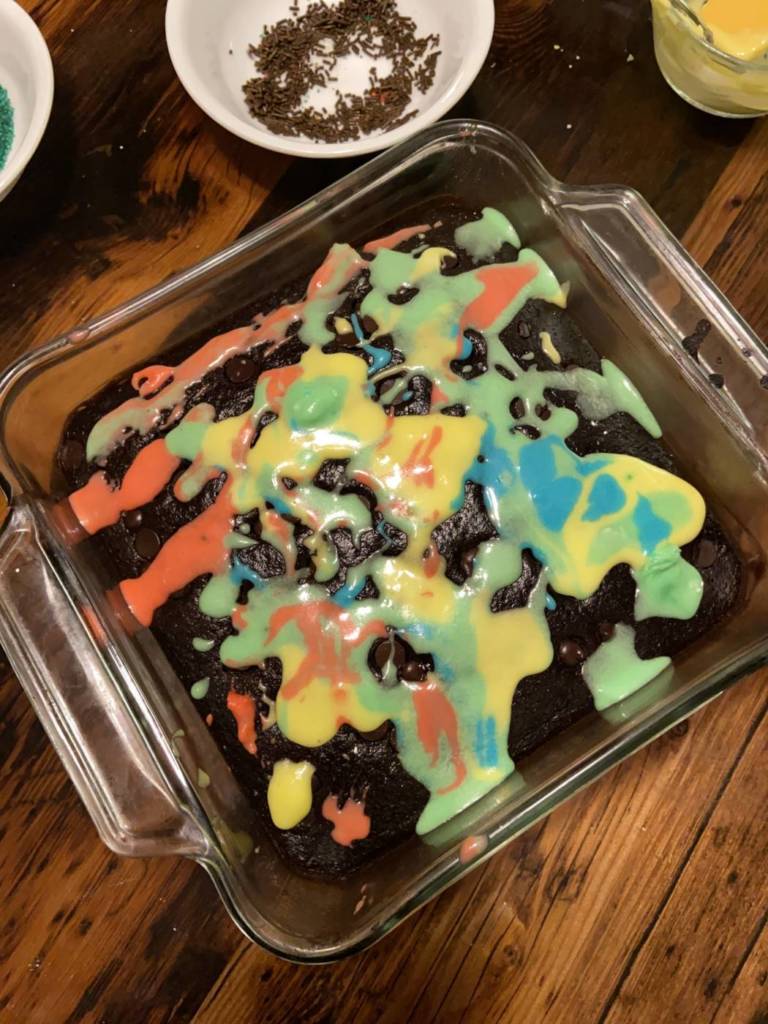
Jackson Pollock move over! 
Ginger Bread Flowers and Flows 
Stay Safe
WEEK XI-X Morning Delights:It’s not what you think it is.
WEEK VIII FOOD ART AND MEMORY
REFLECTIONS
As I read over my notes from this week’s reading, it became apparent to me that food was more to me than just a physical thing or an object resulting from complex process of production and distribution. As I looked at the prehistoric tracings of hunting animal figures created by our ancestral family, I asked myself what was so important that it warranted leaving images of hunting for food on cave walls? Aside from food as a survival imperative, why do humans have a more than a passing fascination with food?
Throughout the history of art, food as the object and/or process of food gathering transcends all the physical and socio-cultural attributes of the actual object. Food is an ontological force and as a form of art becomes an expression of humanity through its physical, socio-cultural and spiritual existence. Throughout our relatively short time on this planet, man has drawn, painted, sculpted, recorded and mediated food in innumerable ways. Food and art have become inseparable as we see in the following works: Antonin’s food as sculpture, Baldwin’s photo-documentation of breakfast, and Calle’s food as color. Food as art may have had its origins in the Palaeolithic pictographs of the hunt, but it has also evolved into an expression of memory and spiritual symbolism such as in DaVinci Last Supper or as a memento mori to what sustains us, as in Hickox food as compost. Even in popular media such as reality food shows or magazines such as the Smithsonian, food as art is recognized and given serious attention. “Food has always is played a role in art: Stone Age cave painters used vegetable juice and animal fats as binding ingredients in their paints, and the Egyptians carved pictographs of crops and bread on hieroglyphic tablets.…¨. “Contemporary artists [Sterbak, Acconci, Chang] have used food to make statements: political (especially feminist), economic, and social”.
https://www.smithsonianmag.com/travel/food-art-cultural-travel-180961648/
“As inseparable as it is from our daily existence, food and the making of it are underscored by longer reflections and shorter epiphanies about life’s commonalities such as love, sorrow, nostalgia, growing up, the good, the bad and the ugly, all of which becomes a part and parcel of your being and becoming”… “As an antidote to this panic-induced present, where the future remains shrouded in uncertainty, we ponder over the intersection of these apparently incongruous worlds of art and food, to suggest how they both are undergirded by the same ingredients of vision, revision, redressal and transformation.”
https://www.artfervour.com/post/artists-cookbook-deciphering-the-secret-ingredient?utm_campaign=SMO_Artists’ Cookbook&utm_medium=
My claim is this: all forms of food art are meant to leave a mark containing meanings beyond the food as object and the process required to obtain the food itself. This mark is intended to reveal something else, a symbolic meaning, a memory of the food object and of the event surrounding the food. This memory also opens a connection to the future, a transcendent meaning of food and the context that surrounds it. The following proposed projects are based on this claim.
THREE PROPOSALS
Morning Delight. No not what you think it is.
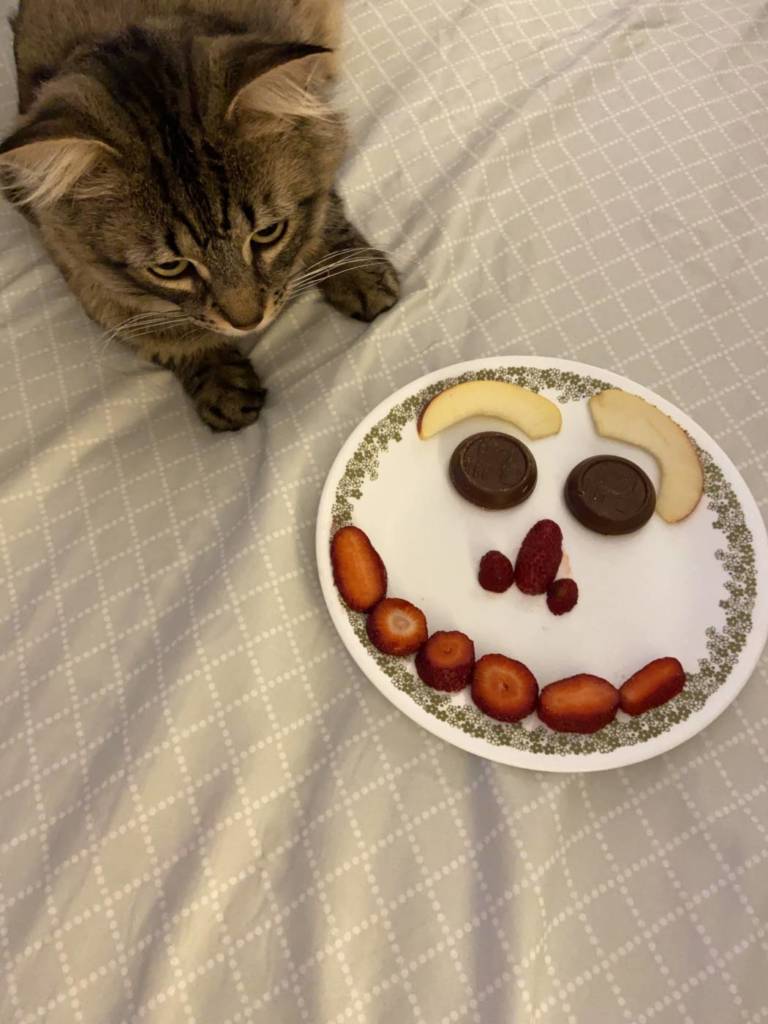
“Baldwin typically engages gastronomic culture with the playful aim of subverting the expectations concealed within social rituals of gustatory consumption in the company of others.”
http://www.no9.ca/ecoartfest/dean-baldwin
This project is a documentation modeled on Dean Baldwin’s work Attempts At an Inventory. The project will document the daily food treats the author and his wife enjoy every morning immediately after waking. The intent to document this daily event is also a means to record the first activities of the day. While it marks the break of the night’s fast it also marks the beginning of a new day and provides an opportunity to commune together before the start of all the activities of the day.
The Family Celebration Tree
This project proposes to gather family photographs in which the sharing of food has been involved. Using those photographs, a timeline collage will be prepared using photographs of significant family events such as birthdays, anniversaries, marriages, family gatherings and other events of significance. It proposes to be a record for the genealogy of events that have created and will continue to create our family.
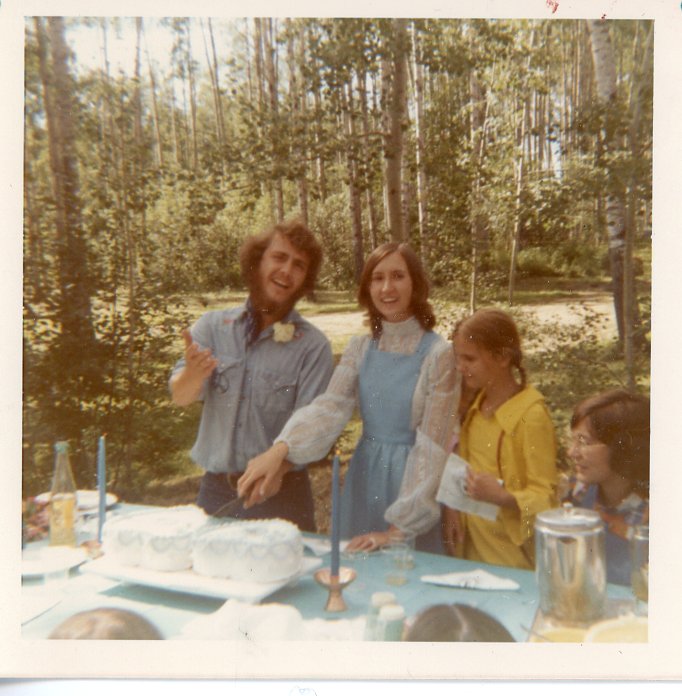
Mèmere Bellerive’s Tourtière
The intention of this video is to show how the Christmas Tourtière is made. Using my maternal grandmother’s recipe, the video will show how, four generations later, the tourtière is an act of remembrance. Though she never said “do this in remembrance of me”, the Christmas Tourtière has become an annual remembrance of my grandmother – a living testament of the love she had for us and which we can all share during the Christmas season.
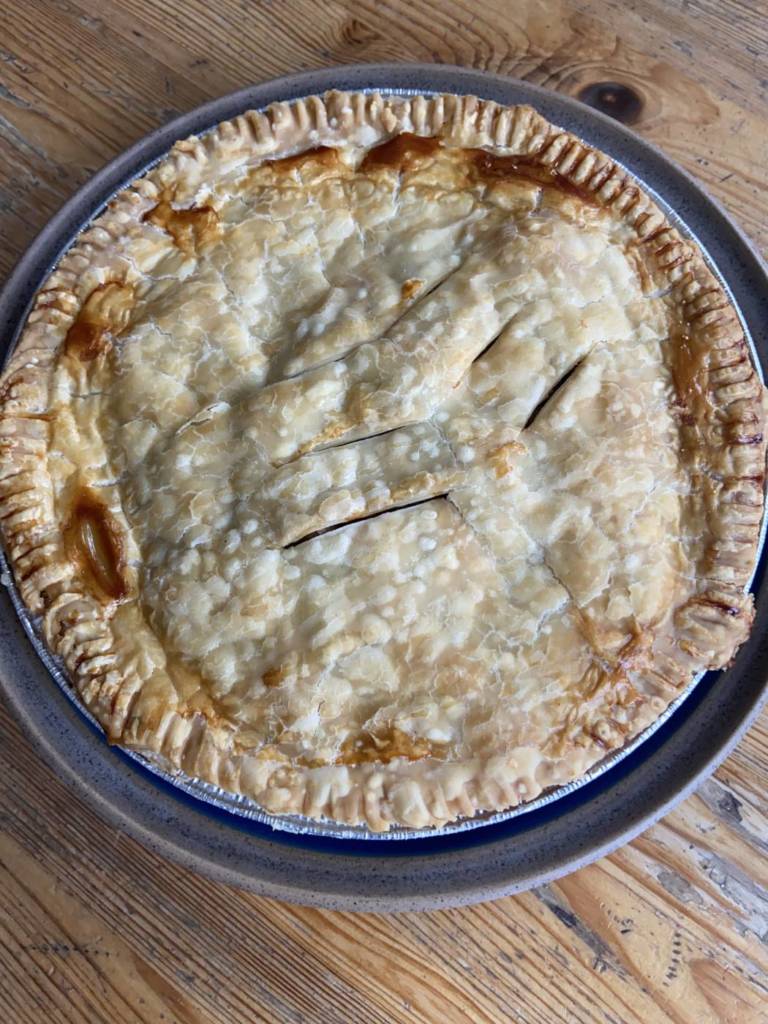
-FIN-
WEEK VII BREAD
REFLECTIONS ON BREAD
When I reflect on bread and the questions raised about bread in the podcast, it brought to mind and triggered many deep personal memories.
I grew up in a large French-Canadian, Roman Catholic family. A large family meant my mother was frequently in need of help or away in hospital having another baby, nine in all. The help came from Grand’Mere Bellerive, my mother’s mom, aunts on my father’s side, and from Mrs. Corbett. Mrs. Corbett was a big-boned, buxom, silver-haired Scottish lady, who, on the many occasions my mother was in the maternity ward, was our sitter and the maker of our daily bread. Her large muscular arms and ham sized hands would bring the yeast, sugar, salt and the flour together into a living thing. She would then knead this being to create enough bread for all the family to last two days. On alternate days from bread making, she created her masterpieces, cinnamon buns; large, thick rolls filled with cinnamon and brown sugar, stuffed with raisins and walnuts, then smothered with butter icing. She would wrap these in wax paper and send them with us for school lunch. I remember licking the wax paper to be certain that none of that heavenly goodness was wasted.
My Grand’Mere Bellerive was also a force in the baking department. She was a small gentle woman whose strength was in her heart. She taught me how to bake, and this skill came in handy especially at Christmas. She showed me how to make the French Canadian festive season meat pie- the tourtiere. I still make it today with my daughters and grandchildren using her recipe. Since I was born on Christmas day, she also showed me how to bake my own birthday cake, just in case my mom didn’t have time! She also showed me how to bake the humble Galette or bannock, a simple fur-trade era scone-like bread which could be made in forty minutes. The Belland crew was going through twenty one loaves a week by that time. The Galette recipe served us well over the years, many a time as a snack on car trips and as the staple on camping expeditions.
I knew much of the information in the podcast. I knew the history of wheat, and the history of transition from hunter gatherer tribes to a society based on agriculture. I know bread has been used and abused as an economic, political and religious force. It has been an instrument of prosperity and of war. Bread has been the double edged sword of development and evolution of western civilisations. I also understand the argument that the development of agriculture and hence bread was one of the worse mistakes of humankind, but I also think it’s a little late for those arguments. The podcast also confirmed by belief humanity needs to act in ways which are fundamentally different if we as a species want different social and economic outcomes.
What brought out the strongest emotions for me was hearing the Gregorian chant, the Hebrew prayer and the spoken words which were used as the backdrop for the story of bread. This music, especially the choral works, wove a rich tapestry of the theological, spiritual, symbolic and the ontological relations that mankind has with bread. My Catholic upbringing instilled in me the sense of a transcendence that the bread taken at communion was more than an unleavened wafer of bread. It was a communion with our faith and social community, but it was also a spiritual communion with mankind. Today when I share bread, I am often moved by a sense of spiritual communion. When I share bread or a gallette at a meal or on a hike with family, friends or other travellers I know I am not the only one in need of sustenance on the trail of life.
For me, bread is a basic physical necessity, but it can also be a spiritual connector with others. This COVID time is a time of stress, threat, uncertainty and isolation. During these times, we search for those things which will bring us comfort and relief. The act of making and sharing bread which gives us physical, emotional and spiritual sustenance bringing us closer to each other. Bread can be a source of physical strength and it is a powerful means by which we can be together, strengthening family bonds or supporting others in this difficult time.
Grand-mère Bellerive’s recipe for La Galette(Bannock)
Take 3 cups flour, 2 tbsp. baking powder, 1 tsp. salt , 1/4 cup sugar, 1/2 cup of lard, 1/2 cup raisins, 1 cup plus or minus of milk or water (enough to make the galette doughy). If it is too runny add flour, if too thick add water or milk. You can substitute other fillings such as jam, marmalade or cheese. The lard can be substituted with butter or margarine.
In a bowl, mix flour, baking powder, salt and sugar. Work the lard into the flour until it is lumpy. Mix in the filling. Make a well in the centre. Add water and stir together with a fork or your hands. With floured hands, work the dough into a ball, knead a few times and press into a circular form. You can use a greased cast iron frying pan to fry the bread over a fire. Bake till no dough sticks to a toothpick or a twig poked into the thickest part of the loaf. If you don’t have a campfire frypan, cut and roll out the dough into strips. Wrap the strips around a green stick and roast over the campfire coals. For a special breakfast treat, cook the dough till golden on the outside, then finish by wrapping bacon strips around the gallette. Use toothpicks or thin green twigs to hold bacon to the twists of gallette.
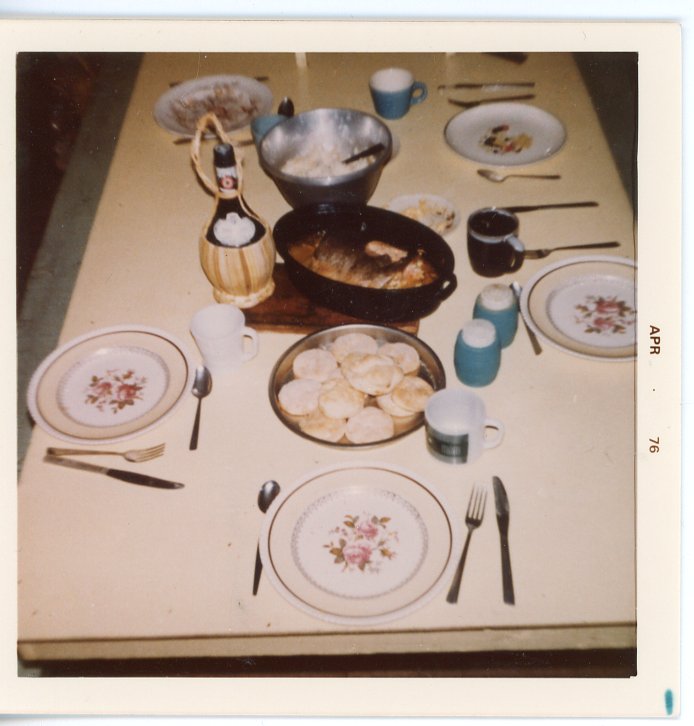
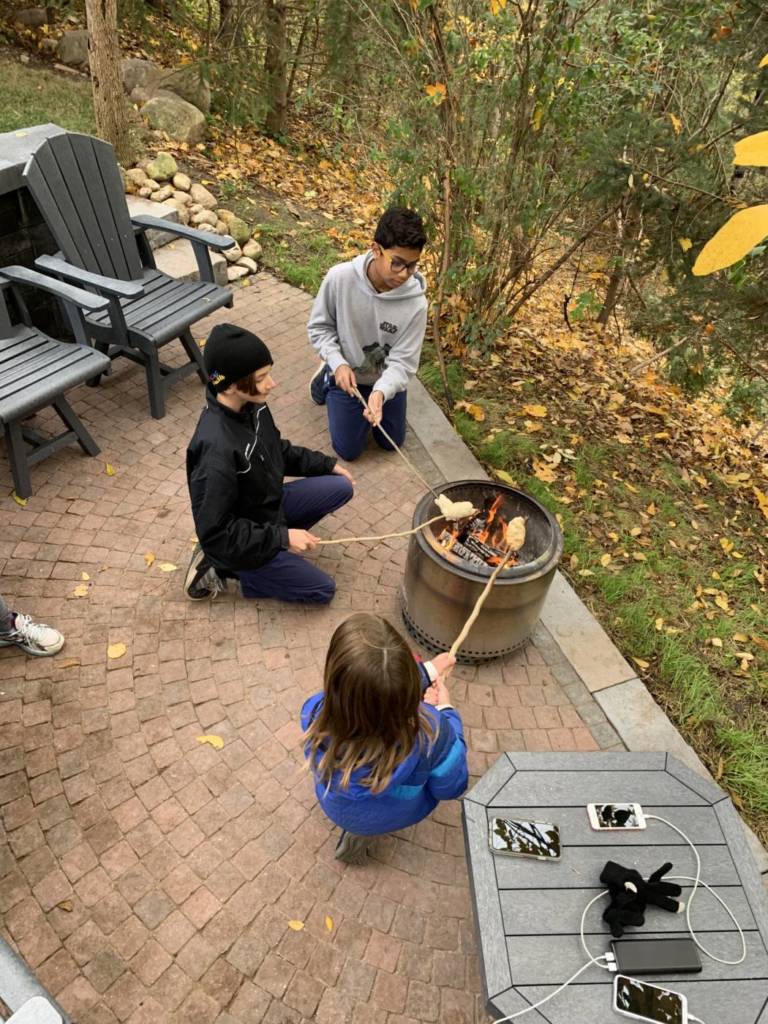
Bread Poetry
https://www.lukejerram.com/breadpoetry/
This was a project, by British artist, Luke Jerram, before COVID. Bread poetry is a collaboration between the artist, poets from around the UK and Hobbs House Bakery. The weekly winning poem got baked into Hobbs House bread using rice paper and could be bought in their retail outlets.
The following bread poem was one sources for my reflection.

Notes

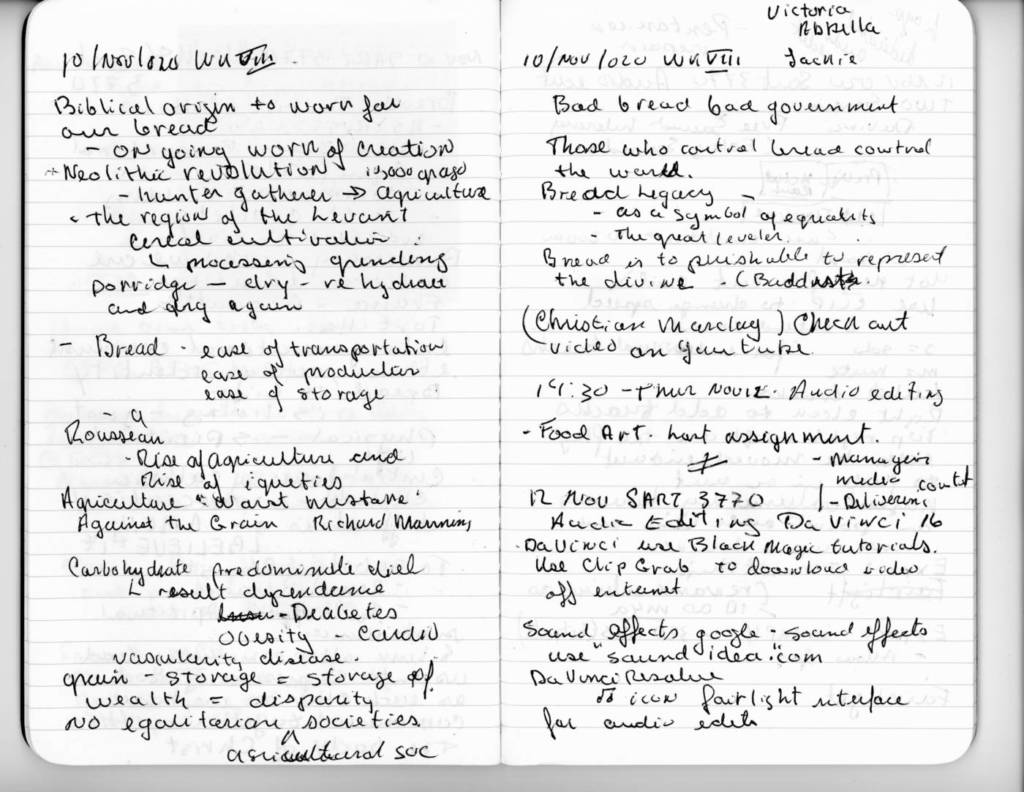
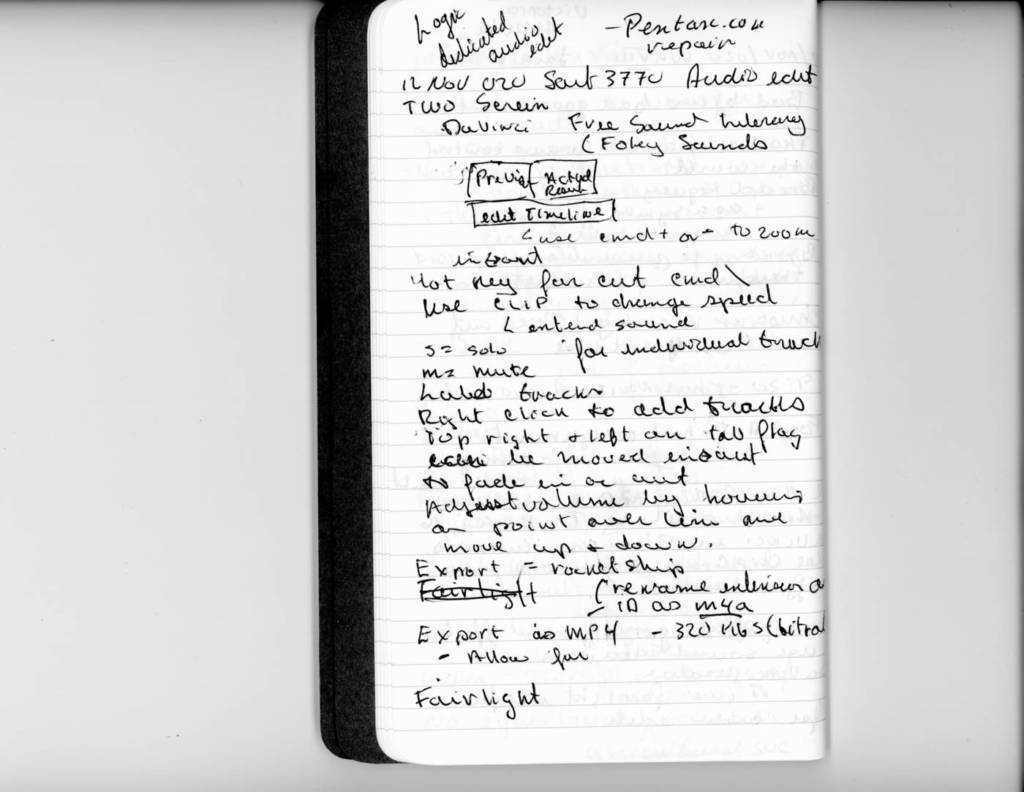
-FIN-
WEEK VII ZOOM
What actually went down.
This video was inspired by the articles of Vivian Castro and the Rosalind Krauss. After some experimentation and technical consultation with Nathan S. I was able to simultaneously record a Zoom meeting with myself. I used two separate email addresses and I recorded the meeting simultaneously on my iMac and I phone.
I had original intended to do a question and answer format, however the more I reflected on the works of Krauss and Castro and with further exploration of the myth of Narcissi and the psycho-pathology of narcissistic behaviour, I changed my approach to the content and format of the video. Zoom is an interpersonal personal encounter medium for meetings, but it is also an intimate and artistic medium as proposed by Krauss. Using the meeting technology of Zoom, the video records an emulation of the behaviour of Zoom meeting participants described by Castro and the narcissistic outcomes of video technology as an art medium as described by Krauss.
I think what has caused me to pursue this exploration was how the medium becomes an intrinsic part of the message. While I had developed a shot list and reminder cues for doing this piece of work, it ended up being done in a one-time shot format with minimal post-production mediation. One of the key insights of doing this project for me was, as the artist/creator or as the host/participant, I created a reflection but also a reflex towards of each the personas captured in the video. I experienced firsthand that while the media was a tool, it was the “absolute feedback” that Castro describes. The video media reflects oneself as self and yet also creates another self which is a reflex and reflection created by the media. As Castro says of Zoom meetings, we are surrounded by ourselves. In this circle we become trapped into being a part of the medium and the message simultaneously.
“THE MEDIA IS NARCISSISM”
Notes
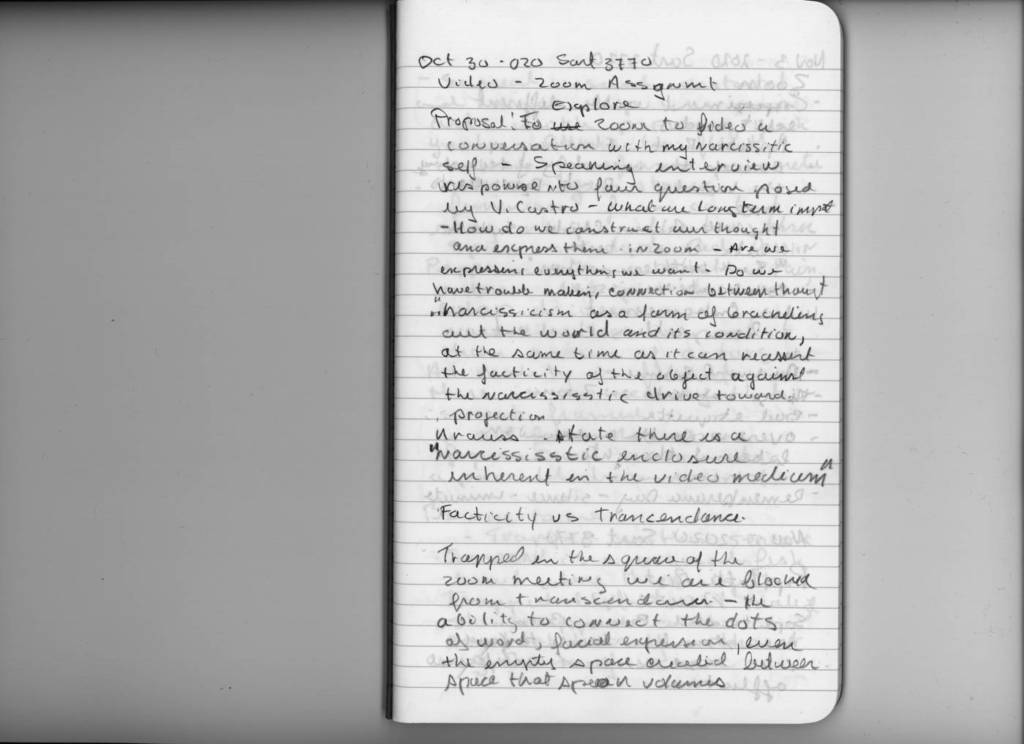


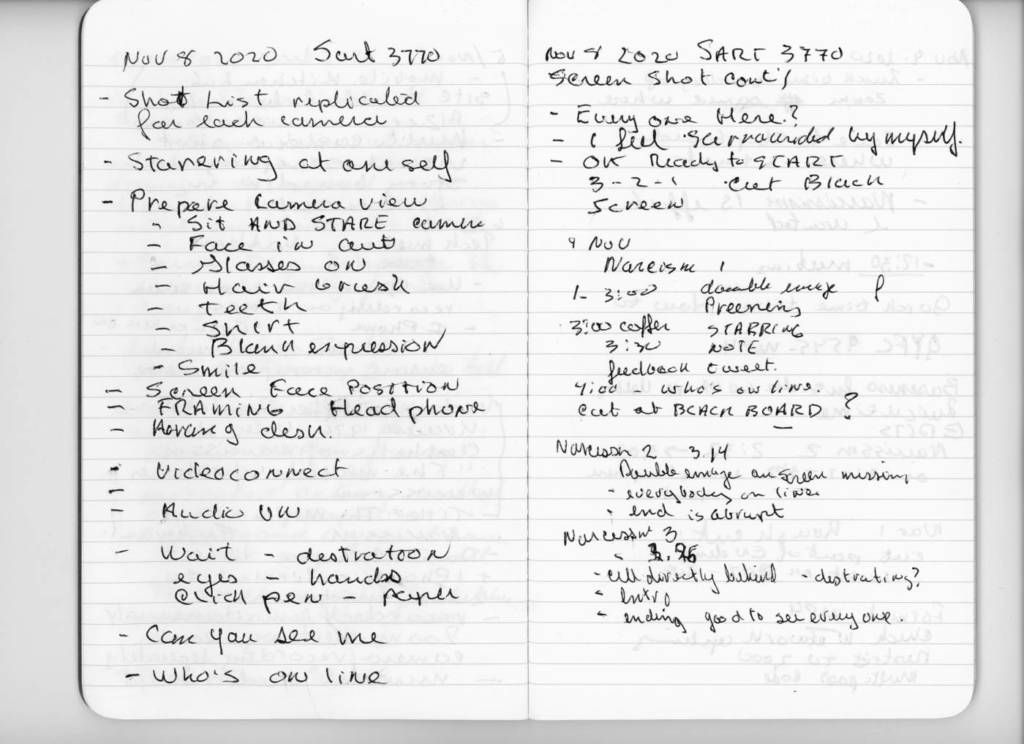
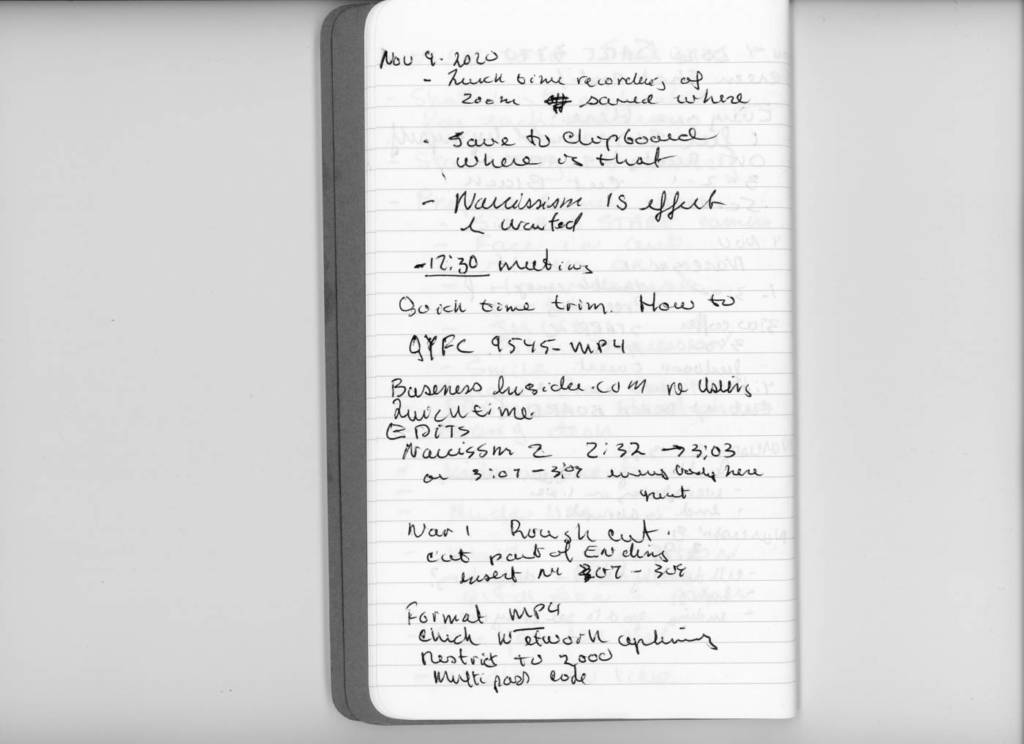
-FIN-
WEEK VI Zoom Video Proposal:
Conversations with Moi.
In her seminal critical paper on the use of video as an art medium, Video: The Aesthetics of Narcissism (1976), Rosaline Krauss raises the question. “Yet, what would it mean to say, “the medium of video is narcissism?””. She prefaced the question after viewing Vito Acconci’s work Centres (1971) claiming Acconci’s image of self-regard “is configured a narcissism so endemic to works…it is a condition of the entire genre.” Vivian Castro (2020) claims that the video art of the 1970s could help explain the “Zoom fatigue” experienced during the period of the COVID pandemic by at home workers. Zoom and other digital meeting platforms with their attendant staring at faces in thumbnail boxes, continuously pulls the viewer to the center of a fixed frame image. She argues that while there is a type of intimacy in a face centred, fixed frame meetings they are not the same as face to face, person to person meetings because body language and other non-verbal clues are masked or absent. This causes more isolation, alienation and frustration in participants of digital meetings. Castro used Krauss’s theory that the immediate and absolute feedback inherent in the video medium surrounds us with ourselves. The screen and camera create a narcissistic circle between the object and subject of the videos. Here is a simultaneous projection and reception of our own self-image, the moi of narcissism . Krauss states that this “reflection and reflexiveness are a doubling back of our consciousness “onto themselves, creating a narcissism between them. Castro concludes that being surrounded by ourselves, immobilized in a video frame computer screen leads us to social isolation creating a disconnect between our thoughts and what we are able to express. Castro describes this as an imprisonment of ourselves in our own self-image: ““ bureaucratic home workers, sadder and sadder encapsulated in our safe homes…staring at squares on the screen.” She concludes that “Video art already predicted it.””.
The purpose of this project is to explore Krauss’ question “what would it mean” if as she claims, “the medium of the video is narcissism”” and Castro’s assertion that our bodies are “trapped in the square of Zoom meetings…”. “We are on the screen, cornered and surrounded by ourselves.”
For this work I will simultaneously record two videos of a single individual, who, in the course of the video will discuss the questions raised by Krauss and Castro. The recordings will present one individual as two: myself and “moi”. Both will be recorded on Zoom. The Zoom meeting with the two selves will be recorded using a second camera from behind, whilst showing the other self on the primary Zoom camera and screen. The other self will face the primary screen of the Zoom meeting and will respond to questions from the other self by turning to the second camera and answering or commenting as an alternative “moi”. “Moi” will then turn back to the front and respond to the statements made by my alter self the other “moi”-who is in the meeting using the second camera and screen. The object and the subject will be trapped in a circular tautology which is described by Krauss and Castro.
Works Referred to
Krauss, Rosalind. “Video: The Aesthetics of Narcissism.” October, vol. 1, 1976, pp. 51–64. JSTOR, www.jstor.org/stable/778507. Accessed 1 Nov. 2020.
https;//www.debredinoire.fr/philosophie radical
Video Test
Notes

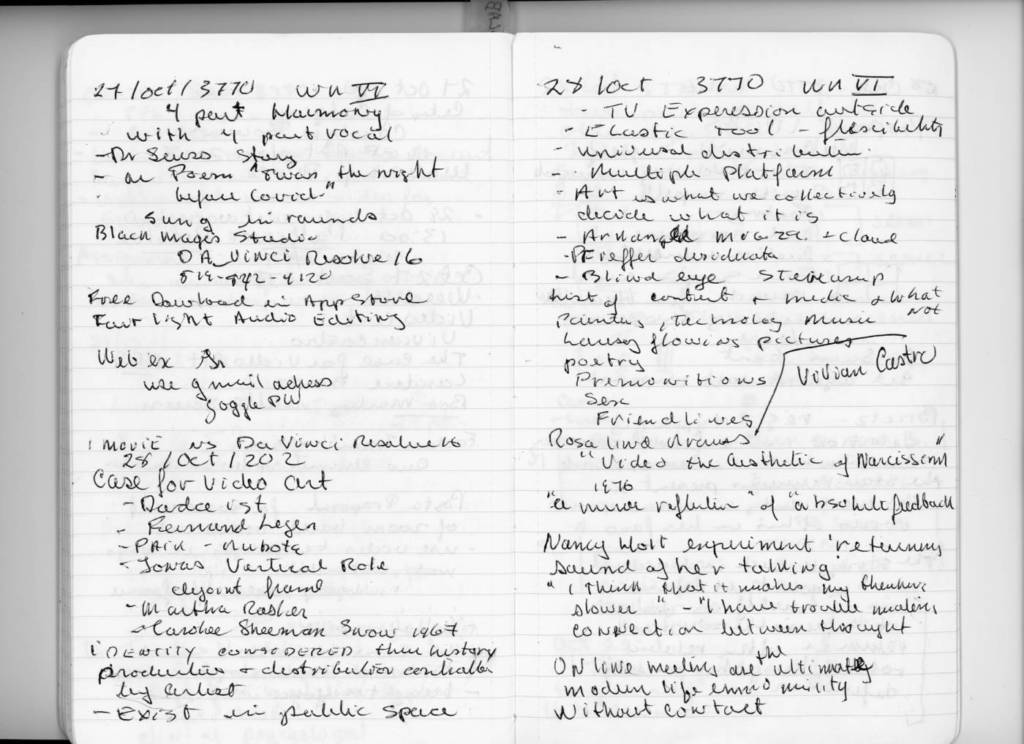

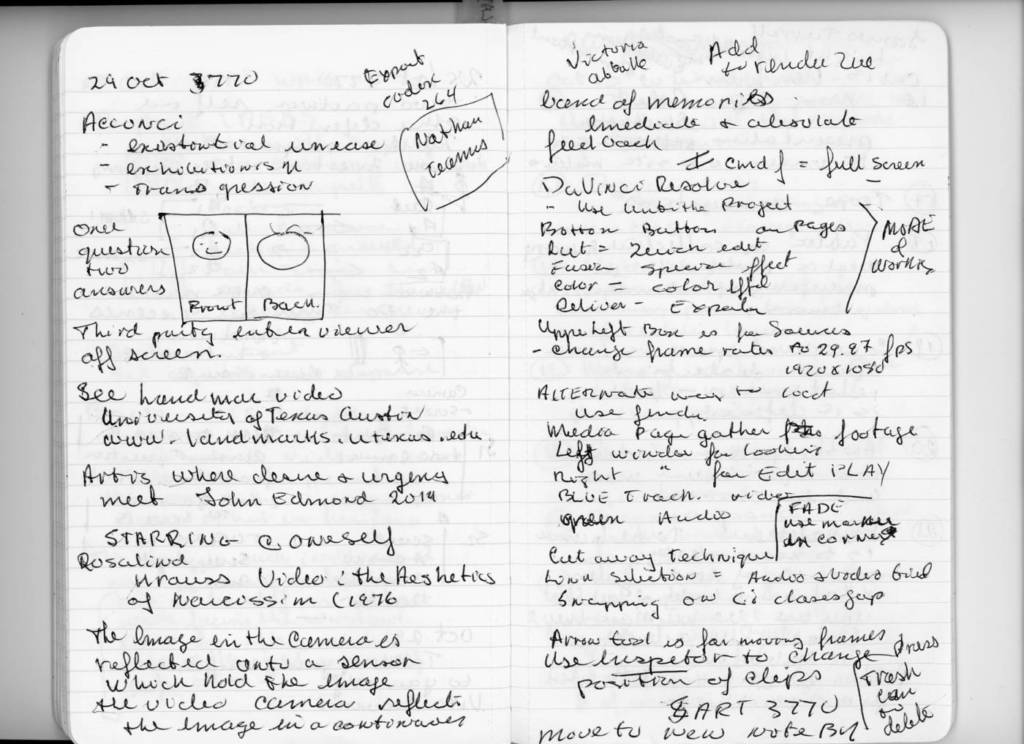
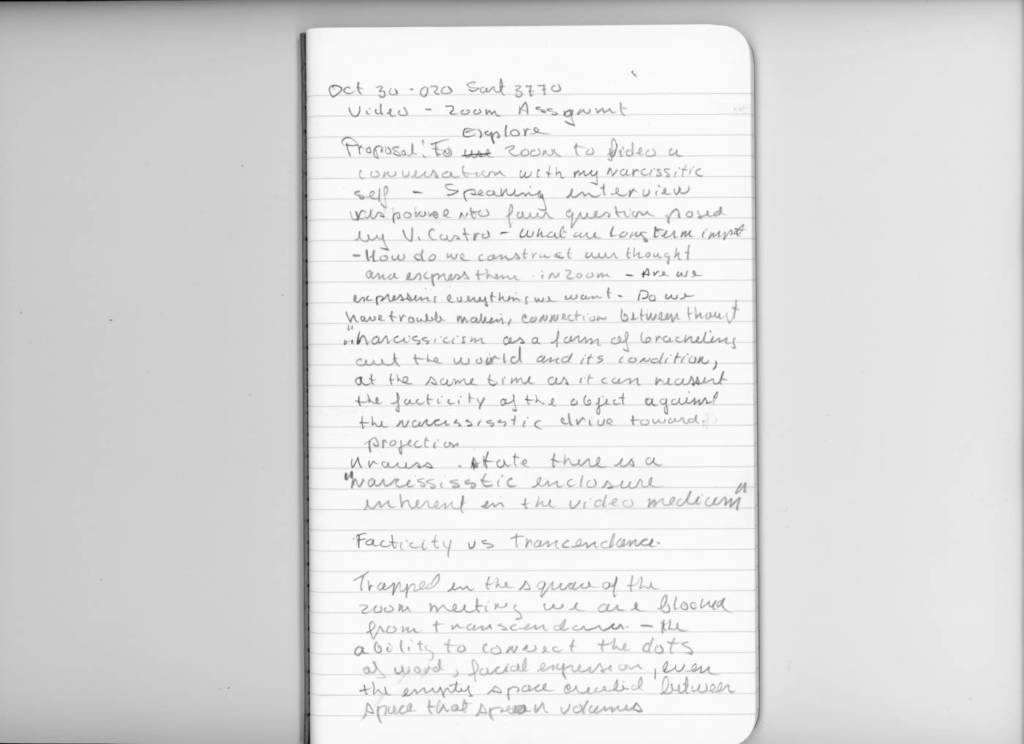
-FIN-
WEEK IV: Video Vivant
Reflections: Adad Hannah
Hannah’s video’s follows in the tradition of the tableau vivant. Hannah makes use of modern digital video media to make tableau vivant portraits, documenting observations of the affect of the COVID 19 pandemic on individuals. The videos records the time of pandemic beginning March 2020 and documents the ongoing impact of this global event on individuals. Ultimately the videos are a time line , an intimate personal tableau of all those affected by the virus.
In contrast to other global pandemics the effects and affects of COVID can be seen virtually by anyone using Instagram. These virtual video portraits are not of a targeted segment of society but a documentary panorama, of the individuals who volunteered to be portrayed to express the affect COVID 19 was having on them at a particular time. This is broad and diverse canvas of those individuals affected psychologically and emotionally. In doing this over an ongoing time period Hannah creates tableau vivant which is a reflection all of us, individually and collectively as we live through these uncharted times.
The videos frame the individual within the confines of their daily lives. The intimacy of the video portrait lives in the daily activities of those persons and those close to them. While the subjects are posed, there is no sense of artificiality or banality of the daily events the subject live every day of the pandemic. Even in the most informal of poses we still get a sense of the tension and stresses on each of the individual person. The video are not mediated or contrived, nor is this street photography, there is no decisive moment no singular image. Each frame of the video is a moment and the video is a chain of moments. In that chain we see reflections of ourselves.
While the videos are shot from the recommended safe social distance this gap becomes filled with intimacy. The personal worries, concerns , the daily tension of uncertainty and the unknown which the pandemic created is seen in the eyes, behind the mask, in the furtive looks of each individual portrait. As the project and the pandemic progresses we witness a change in the demeanour of the individuals and the social distance bubbles of individuals created during the pandemic. In the later videos there is noticeably less formality. The poses are less rigid, a state of relaxation , perhaps habituation or acceptance of the new reality is visible.
The full frame portraits captures moments which are not historic, they are the seconds and minutes of life with COVID 19. They track and mark the changes the virus has imposed on our every day social norms. Over the time of pandemic, the collective of the videos becomes a larger tableau which is witness to the changes collective behaviours. In the beginning phase of the pandemic personal fear and anxiety is expressed in a the tension of the poses, eye movement, gestures of strength or resistance . This tension creates a relationship of common feeling between the viewer and the subjects. As the initial Covid phase crested and waned, we see a less rigid attitude in the poses, the individuals and bubbles are more congenial. In these later portraits the images appear less fearful, fewer frowning brows and tense stances, cautious smiles are visible, movement appears less restricted as life is slowly re-opened. Is this an expression of acceptance or a resignation to a new norm? Are we becoming accustomed or tamed by the virus?
Video Portraits
Notes
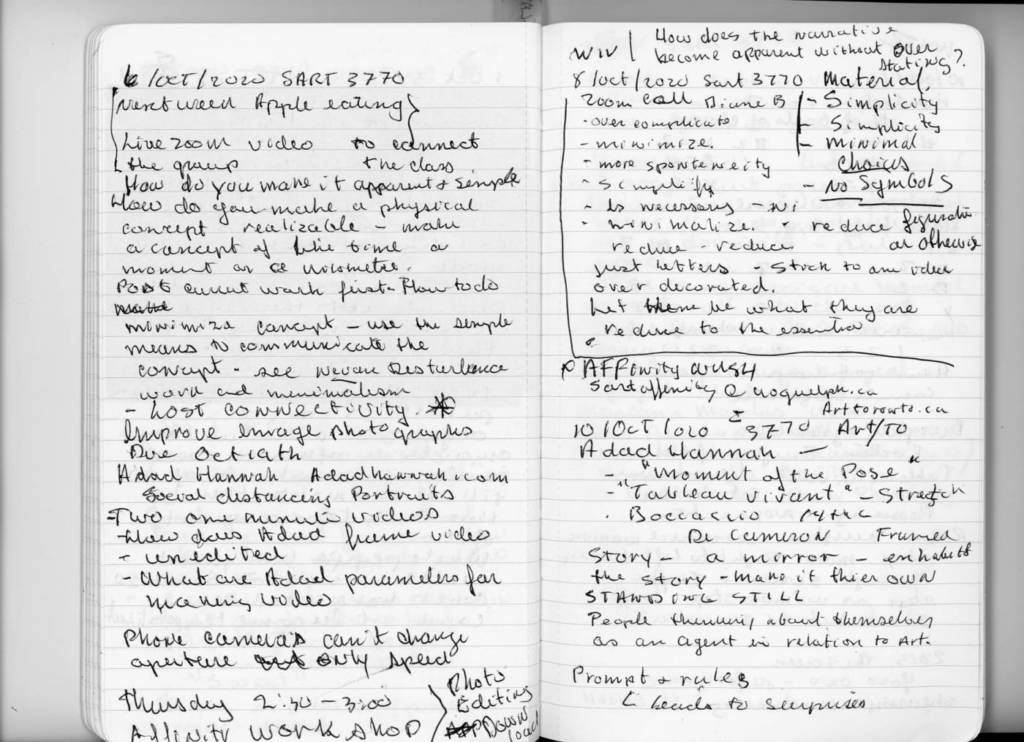
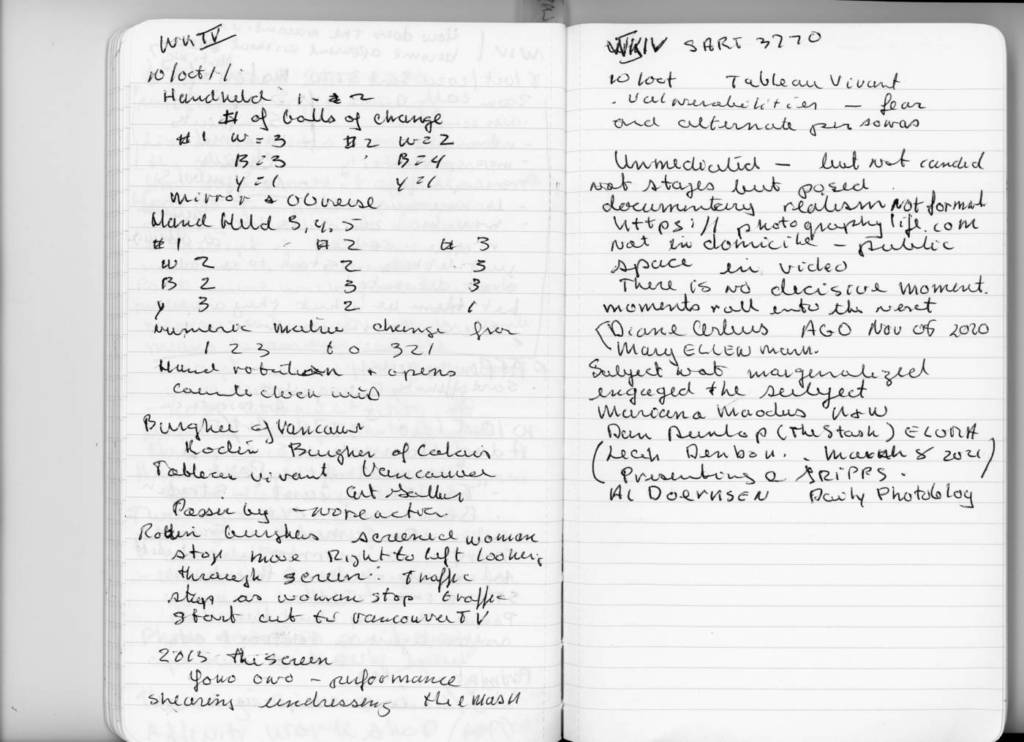
-FIN-
WEEK III: A Banner Week
The banners produced this week were inspired by two phrases in the ar Canadian Arts article Dirty Words : Interesting. The first banner is adapted from Joie T. Arcand work Neon Channel and inspired by the Cree syllabics translated as “Don’t Be Shy”. What intrigued me about the words were the syllabics written using a neon sign which unless you can read Cree could mean anything. The translated phrase Don’t be Shy could also have multiple meaning depending on the context. Arcand intends the Cree words to be simple and gentle reminder to the indigenous community not be shy about their language and their identity, She also uses the words to be an invitation to non indigenous people to not be shy about building a relationship and future with the native peoples of Canada. In this banner I used a series of LED light panels which are placed in the stairwell of our “Sweet” where we live . The light panel can be programmed to change colours. I placed red coloured Cree syllabics over the pink coloured panels and then placed the phrase “Don’t Be Shy” around the free space of the light panel form. I selected a clean non-serif type style and used various colours for each letter. The palette outside text is intended to create a sense of calm through the use of tones of the primary colours of blue and yellow. The pink tone can be modulated using the application of the panels. By changing the color of the light panel I can emphasize the feeling of welcoming and sense of arrival to our home. This modulation of colour also change the hue of the surrounding letters making them disappear and re-appear, like shyness and sense of welcoming to our “Sweet” place.
The second phrase is “Ongoing Temporality”, a descriptive term describing the detached, removed or cool attitude of the abstract and conceptual art of the 1960’s and 70′. At first I thought the terms were contradictory, an oxymoron of sorts. The more I reflected on them it became apparent that the words are opposite sides of the same coin. This idea of contradiction brought to mind the nature of the COVID virus and the pandemic time we are now living in and through. Both the virus and the pandemic are ongoing and temporary. I used the mask to represent both sides of the contradiction. One side in outward, the pandemic, the blue mask, the white side is inward , the virus . Thus one mask is the ongoing, the other the inside is temporary. We are caught in the temporality of both. I chose white paper and a cool palette of colors to suggest the subtle nature of the virus being invisible but also very visible in its effect. It masks a potential severity but does not mask its contagion. We can contain it with our masks, just as we contain so many other vulnerabilities with different kinds of masks. COVID has changed our ongoing temporality. As every moment is temporal and and ongoing the meaning and the effects change within the internal and external context of those changes.
Don’t Be Shy
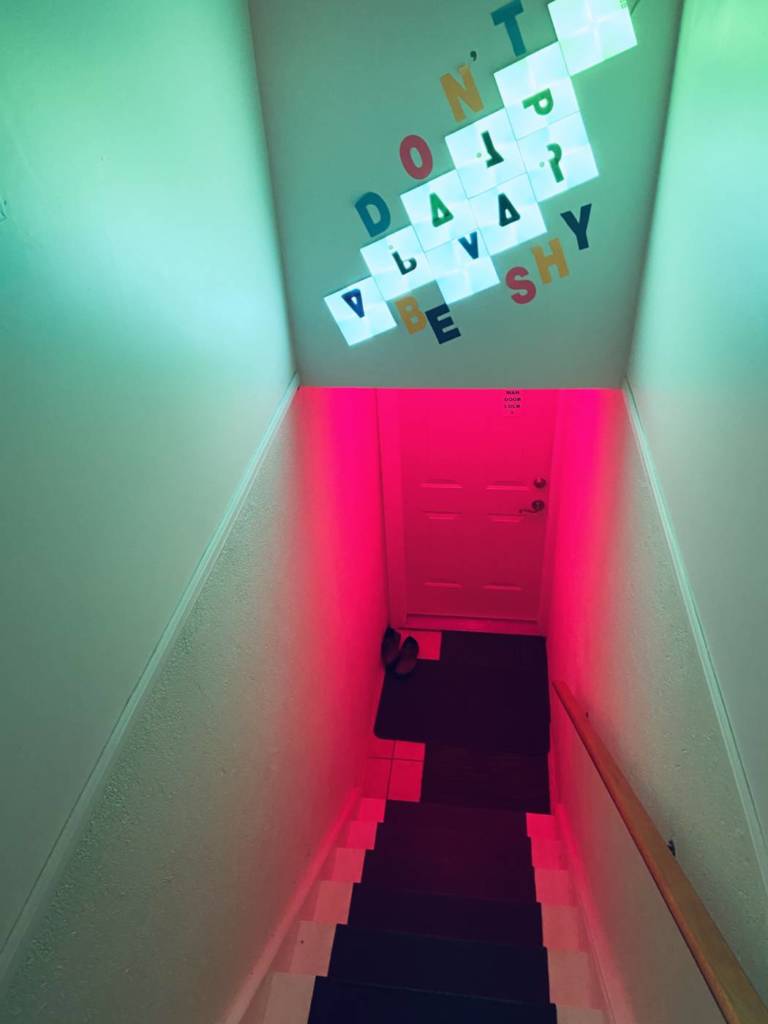
This attempt is confusing because the text gets lost in all the other elements in the picture.
Ongoing Temporality

After thinking about the feed back I received, I changed my approach simplifying and eliminating everything that could be could be considered extraneous. All but one of the texts are from various painted rocks that have been placed throughout the neighbourhood since the beginning of the COVID 19 pandemic. Though these are part of a larger photographic documentary project, I thought many of the text could stand alone as maxims about the pandemic. These simple maxims get to the heart of what COVID is all about. The panels could be read separately or together.
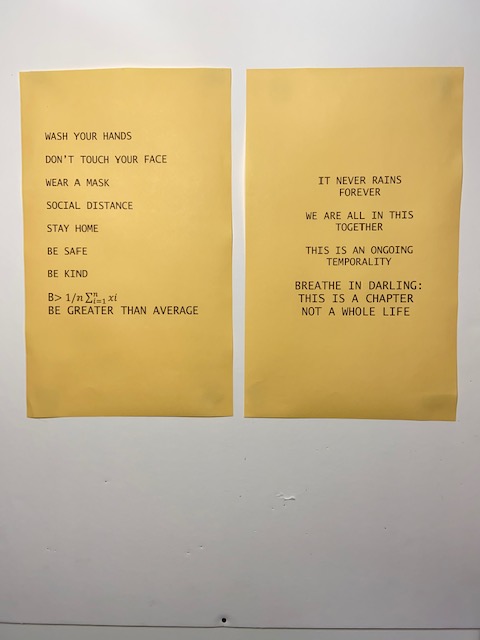
Notes
WEEK II : Text as Art.
Text as art can be traced back to medieval times. Think of The Book of Kells a manuscript where illumination creates gold embossed text surrounded by images of vines, angels and demons. Fast forward to the post-modern period where a growing number of artists incorporate text into their artistic practice. From the collage work of Picasso to the surreal work of Magritte’s This is not a pipe and the Brillo box pop art of Andy Warhol, text is recontextualized and restructured into art. It was not just in art but also in literature that text and language were restructured. In poetry, e.e. cummings changed the physical structure of his poems and Gerald Manley Hopkins reframed the sound structure his poems.
When text is the art beyond the words.
The change of text to art questioned preconceived notions of what art is and opened the windows on new concepts on the use of the written word, creating a visual language not meant to be read but to be viewed new visual language went beyond the letters and the literal text. What was once perceived as letters, or words with a singular meaning became signifiers of multiple meaning. The signifiers, text, letters and numbers were recontextualized and restructured to evoke uncomfortable truths, and to create tension, ambivalence, satire and irony. Often these texts were meant to reveal and protest against social and cultural inequities and injustices. This art form was expressed using a wide range of media from performance to posters, to billboards, T-shirts, buttons and bumper stickers. It appropriated many techniques from advertising, the graphic arts and, more recently, digital media. Meant to provoke and often to shock, this art had the capacity for a much wider distribution. Ultimately it has become an interrogation of and reflection of our society and culture.
Joi T. Arcand and Nadia Myre use text to refocus the viewer perceptions and cultural biases about Canada’s indigenous people. The prejudices and racial injustices created in Canada’s colonial past are still deeply rooted in our present day culture and behaviours. These works call that past and the present into question. Alisha Wormsley, an Afro-American artist, uses a public advertising billboard as her medium to proclaim an uncomfortable future for the passersby. Each artist uses a particular medium. Specific colours, fonts, type scale and design space are used in subtle and not so subtle expressions of lost identity, social injustice and racial inequities. But as Arcand, Myre and Wormsley show, their pieces can also be proclamations of hope. Each artist creates a visual callout to the viewer to shift their beliefs from the past and to imagine a different future for indigenous and black people.
Joi T. Arcand

Joi T. Arcand is a First Nations artist from Muskeg Lake Cree Nation in Saskatchewan. In her Here on Earth Future Series she creates and photographs streetscapes with Cree signage. Cree is a syllabic language using a system of phonemic spelling invented by James Evan, a white missionary in 1830. Arcand interjects syllabics Cree onto street and business signage to create a new optic of and for Indigenous people. It creates, as she says, “an alternative present”[1] and in doing so she presents a radical hope that we can all move beyond the colonial injustices of the past. The thick rounded borders of the form, shape and glyphs of the syllabic texts are in a pink hue. The pink represents kindness and tranquillity. The syllabics even though angular evoke a sense of flow and a unifying geometry binds the text together. The texts are signage on ordinary buildings found in the sparse streetscapes of prairie reserves and towns. The scale of the signage fits over existing signs and is not overstated. Yet these new signs change the landscape, creating an indigenous presence in that space. They evoke a prairie landscape that is filled with a different meaning; a meaning that is not bound to the logic of terra nullius (that place that exists without history or politics prior to European Settlement) and to the myth of Indian savagery and degeneracy.1 The signs are signifiers that these places are of the Cree. They are indicators that exist in a place beyond colonialism. The simplicity of the shapes and the muted hues create a visual field which interrupts us yet welcomes us to the threshold of “a radical hope,… a new kinship and a new world making praxis”1.
Nadia Myre
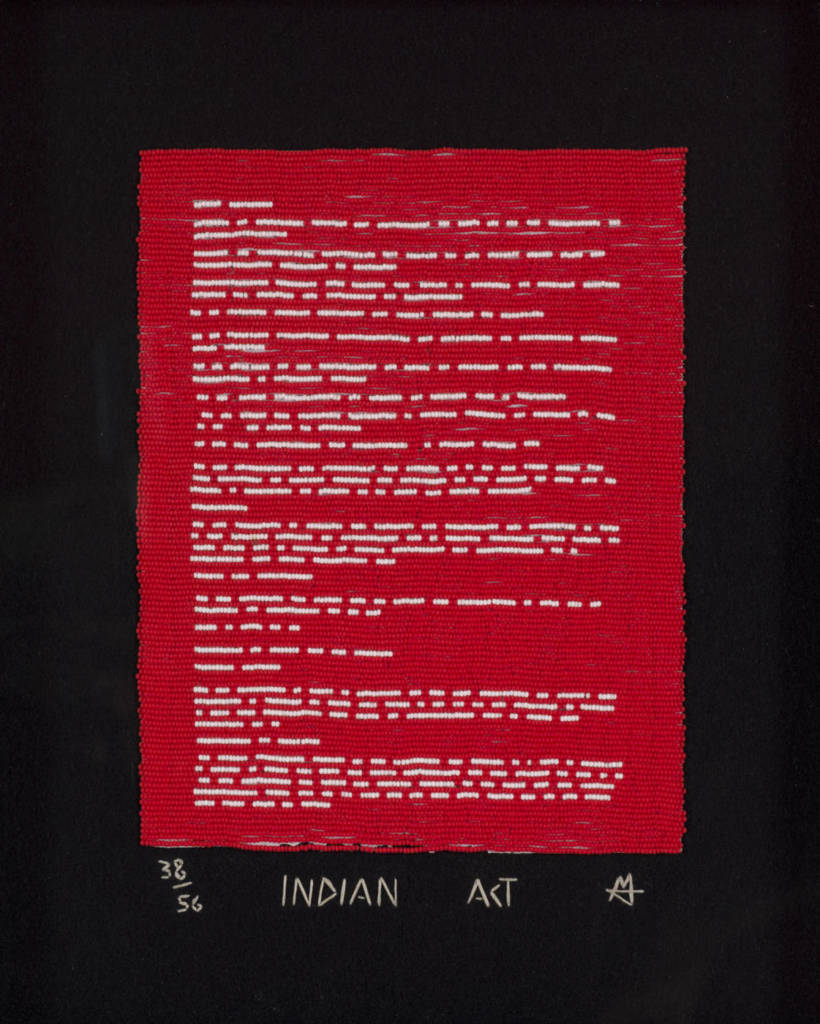
Nadia Myre is also a First Nation artist, an Algonquin of the Itigan Zibi band in Miniwaki, Quebec. She reclaimed her Native status in 1997. Her status, hence, her otherness, as it is for all people of First Nations and Metis ancestry, is governed by the Indian Act of 1876. This singular piece of British colonial legislation still governs every aspect of native life and identity. Her work Indian Act is a piece of beadwork created over the first fifty-six pages of the legislative text. By overwriting that text, she reclaims in a small part the identity of Canada’s indigenous people. The bead work replaces the words of the Indian Act with white beads and the red beads replace the white space surrounding the text . The beads are symbolic as they speak to the value of the bead which was used as a trading currency during the fur trade. Myre interchanges this currency for the values of colonialism imbedded within the words of the Act. The words then become white currency and the space surrounding the text is the red currency. Myre reframes and recontextualizes the meaning of the words in the Act. She deconstructs the Act, flipping the colors and using the beads to show the red space as First Nations territory that was lost due to the broken promises since the passing of the Act. This deconstruction illustrates how the colonizer misappropriated the indigenous understanding of the words and used the words to colonize and suppress Canada’s First Nations. While the beadwork piece is a modern artifact, it redacts the white words and reappropriates their symbolic power. The red beads recreate space that was lost by the First Nations people. The piece strikes me with its simplicity of color, red and white, and the beads, once an article of value and power, which are used here to act in opposition to the value of the legal words and white spaces of the Act. It is a modern palimpsest covering the original text, demonstrating the power of erasing the past using a traditional material. As a form of Braille, the text can be felt and the energy in the text is sensed through the space occupied by each color. In this way Myre has created a symbol of radical hope. The past must be written over in order for there to be hope for the future.
Alisha Wormsley

Alisha Wormsley, in her work The Last Billboard, expresses the theme of radical hope again. A 36 ft. long black billboard adorns the roof of a building in Philadelphia. The text in large white block type letters reads, “ There are black people in the future”. The scale of the piece, the placement atop a building, the white text against the stark black background are different from the thousands of advertising roof top billboards across the city of brotherly love. It also proclaims a future. This simple and eloquent text brings forth an uncomfortable prophecy. The voices of the Black people are rising, claiming a radical hope for their people in America.
Arcand, Myre and Wormsley, through their individual text art, engage the viewer in the present while offering them an “alternative present” which at the same time points to a future narrative.
References
[1] https :canadianart.ca/features/optics-language-joi-t-arcand-looks-words/
https://150ans150oeuvres.uqam.ca/en/artwork/1876-indian-act-by-nadia-myre/#description
http://https//www.poetryfoundation.org/harriet//functional-white-crafting-space-silence
https-//www.asymptotejournal.com/visual/leslie-ross-text-and-image/
https-//www.typeroom.eu/from-picasso-to-ed-ruscha-the-use-of-text-in-visual-art-explained
Notes
WEEK 1: IT ALL STACKS UP
My book shelf is an archive, a memory of moments lived, past and present. The books are bound through time, they are links to experiences, thoughts, people and places. It is a reflection of my history and the history of those closest to me.
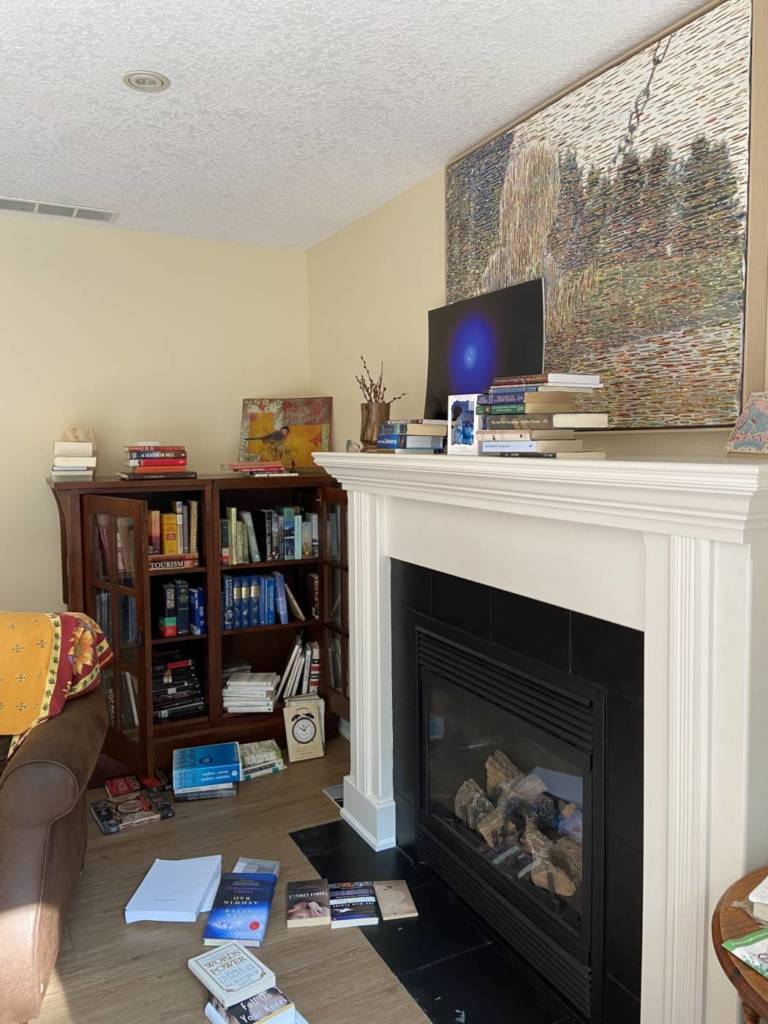
My family history links me to voices past and present. Individual and collective memories. Conflict of cultures and world views form the past and a present reality.
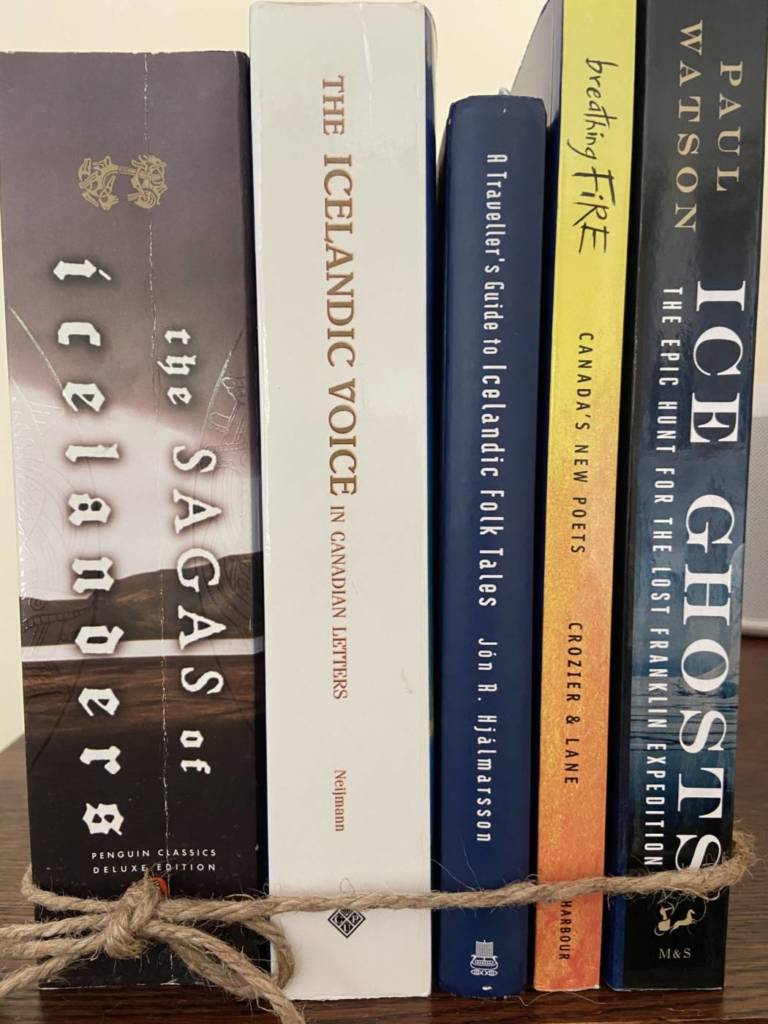
Iceland is my wife’s ancestral place. Living in the shadow of fire and ice created tensions and fear. In the 1880’s Icelanders moved away from winter, darkness, starvation. Their struggles gave voice to a culture and its people, here in Canada. Could the COVID-19 do the same?
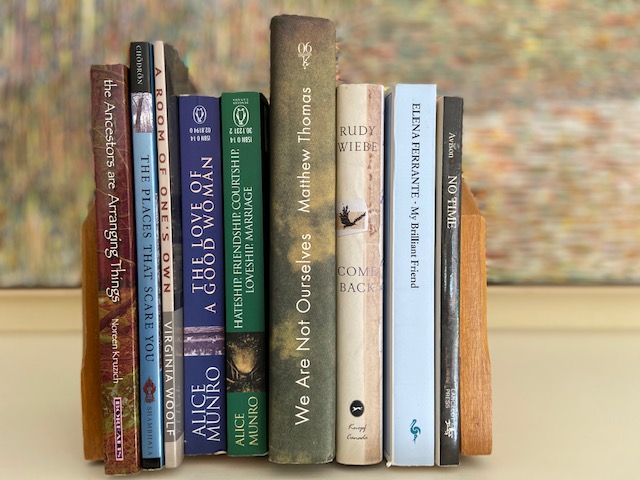
A life intertwined, a long conversation flowing through the years, something gets lost but memories persist. We are different and time has made it more so. Each thread of our relationship runs through the warp of time and our lives, knotted in memory. In this stack the ideas expressed above seem to get lost because of the vertical stacking of each book

Words are not all they are made out to be. Is devotion made more powerful through words prayed on our knees? The stacking of the books was an experiment on stacking books vertically in a horizontal plane. The relationship between the three words, power, knees and devotions gets lost in all the text of the first title.
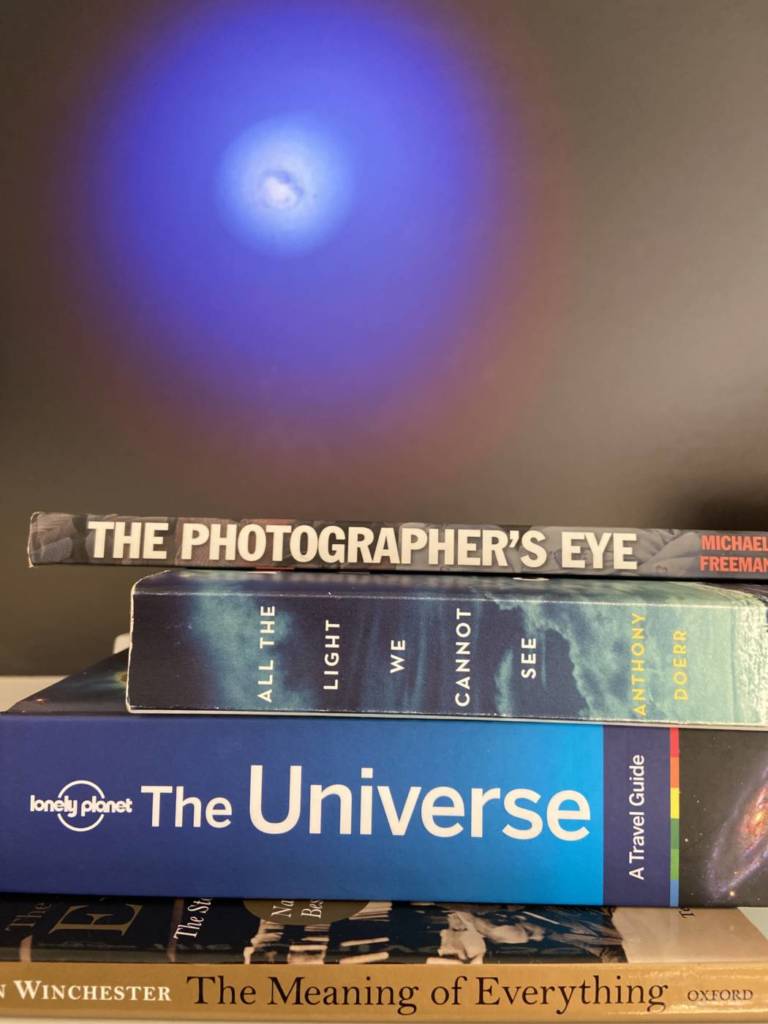
In this first attempt I realize that the four books express too many ideas. It misses the my main point of what I was trying to express about the photographer eye which sees the light as form and metaphor beyond the physical reality.
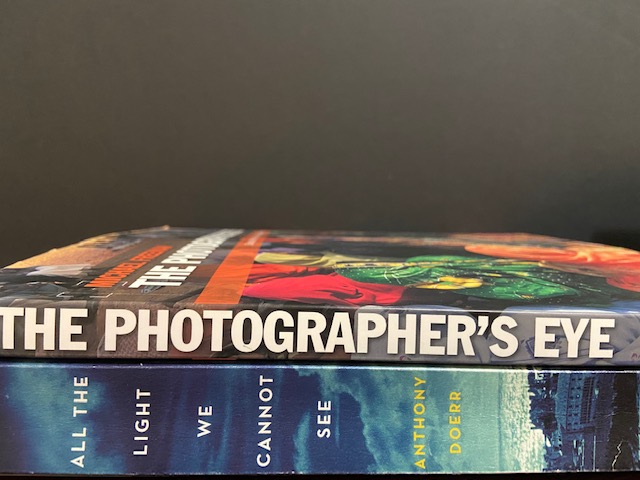
In this stack I simplified the message by removing any extraneous information including the photo and I think this gets the message across more effectively.
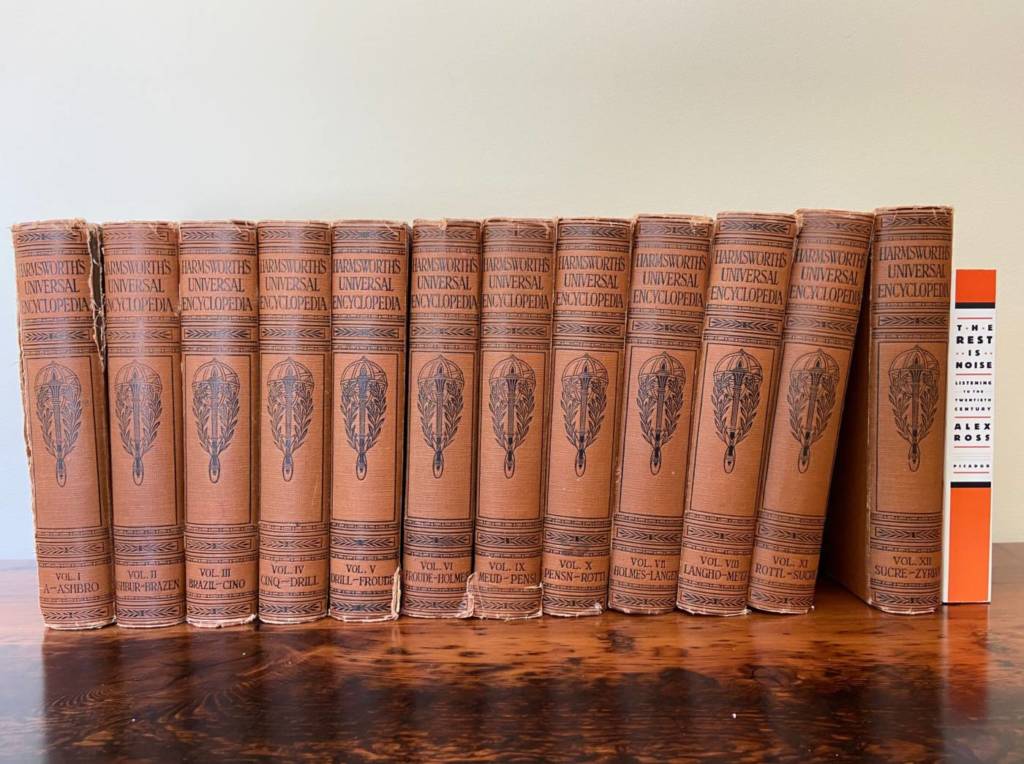
Harmsworth claimed to contain all the knowledge of the universe in 21 volumes. The problem today is too much information. It has become noise, the challenge is how to decipher the knowledge from noise. I think this stack conveys the idea. It could be improved upon with a black foreground and background to make it appear that both are floating in an ether.
MAQUETTES
NOTES
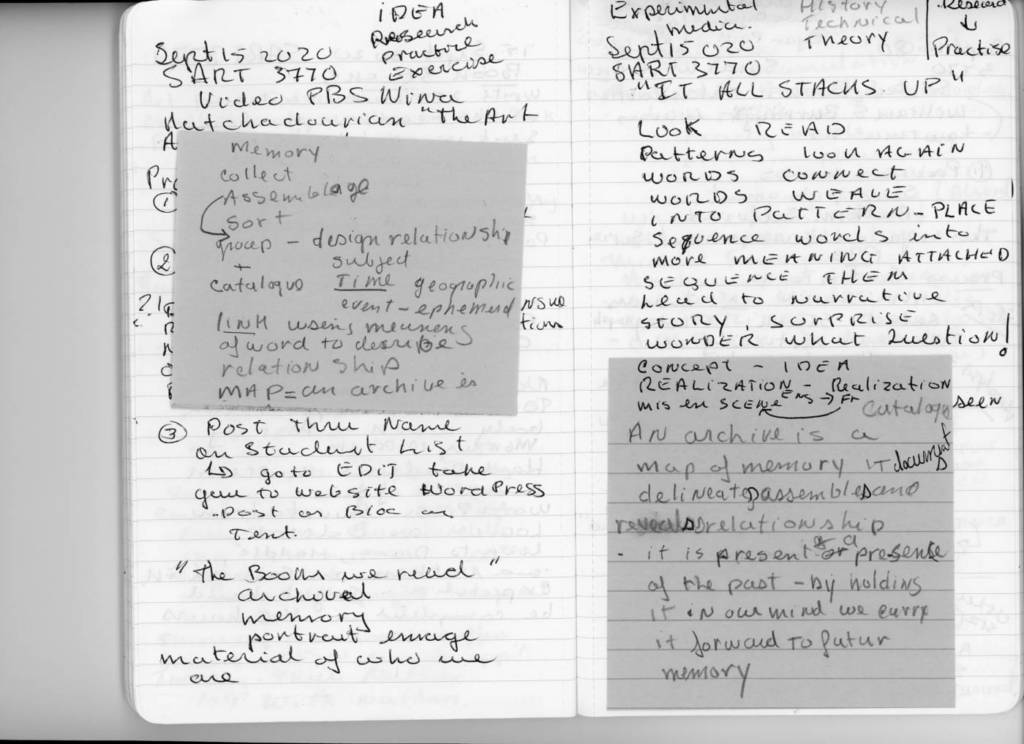
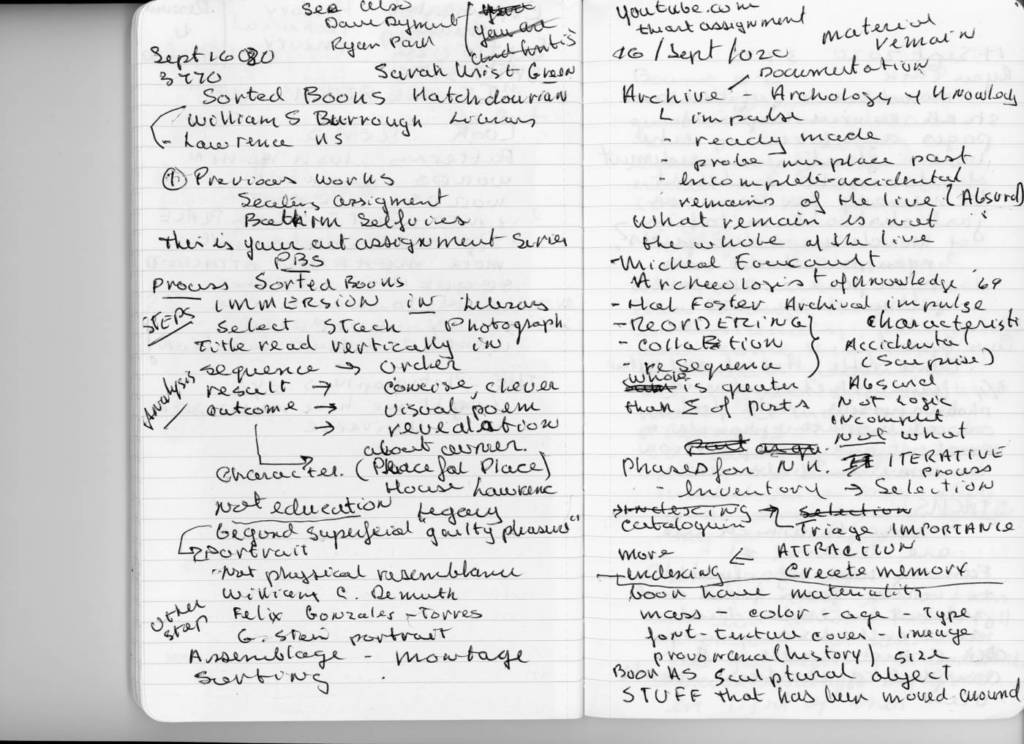
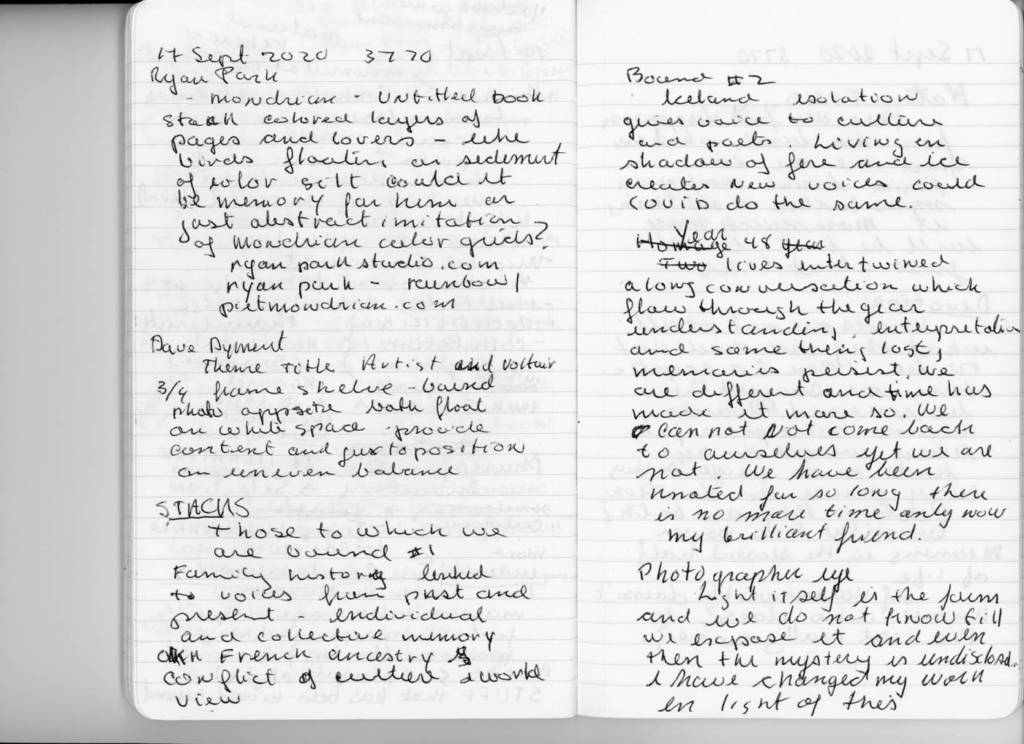


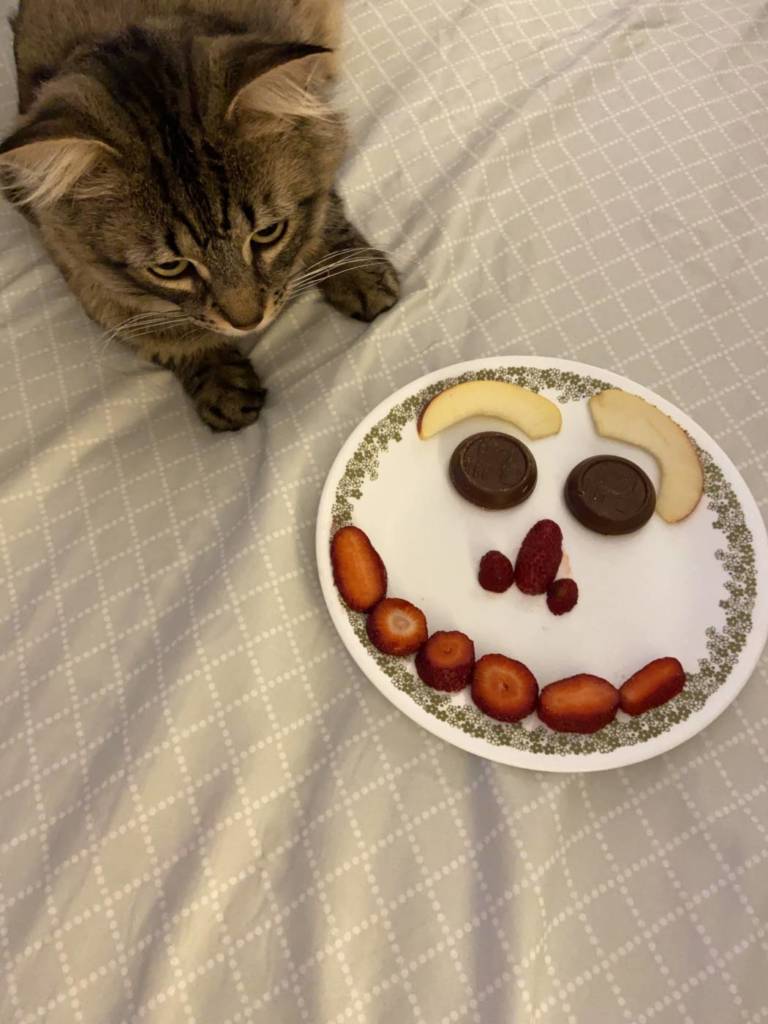

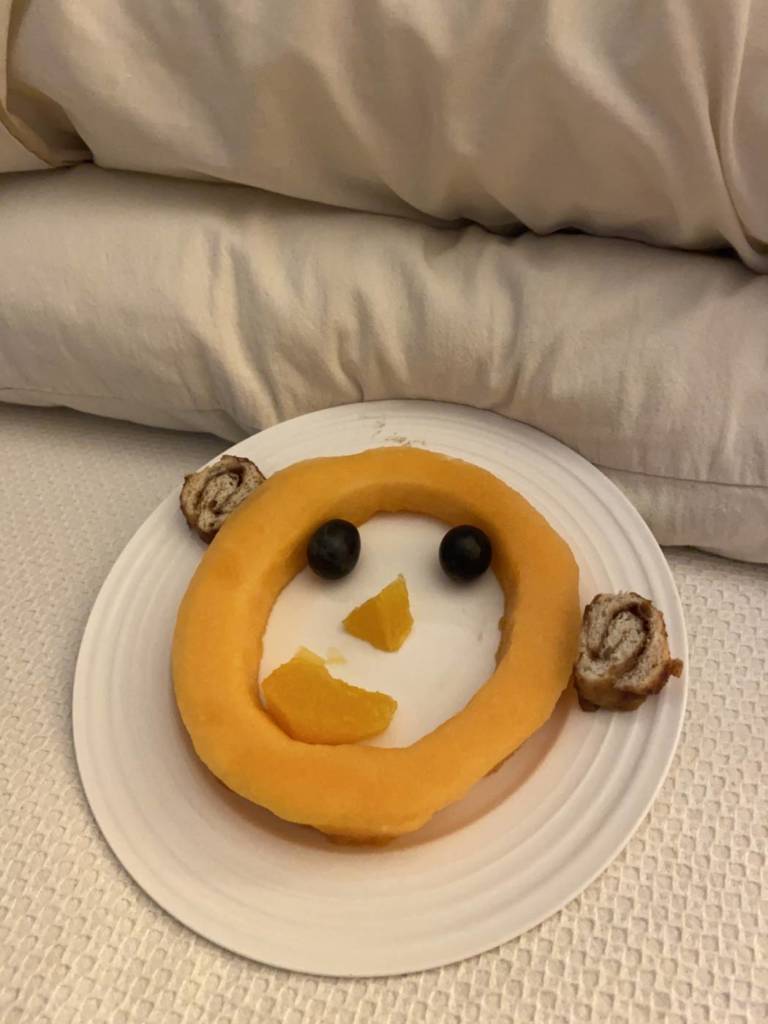

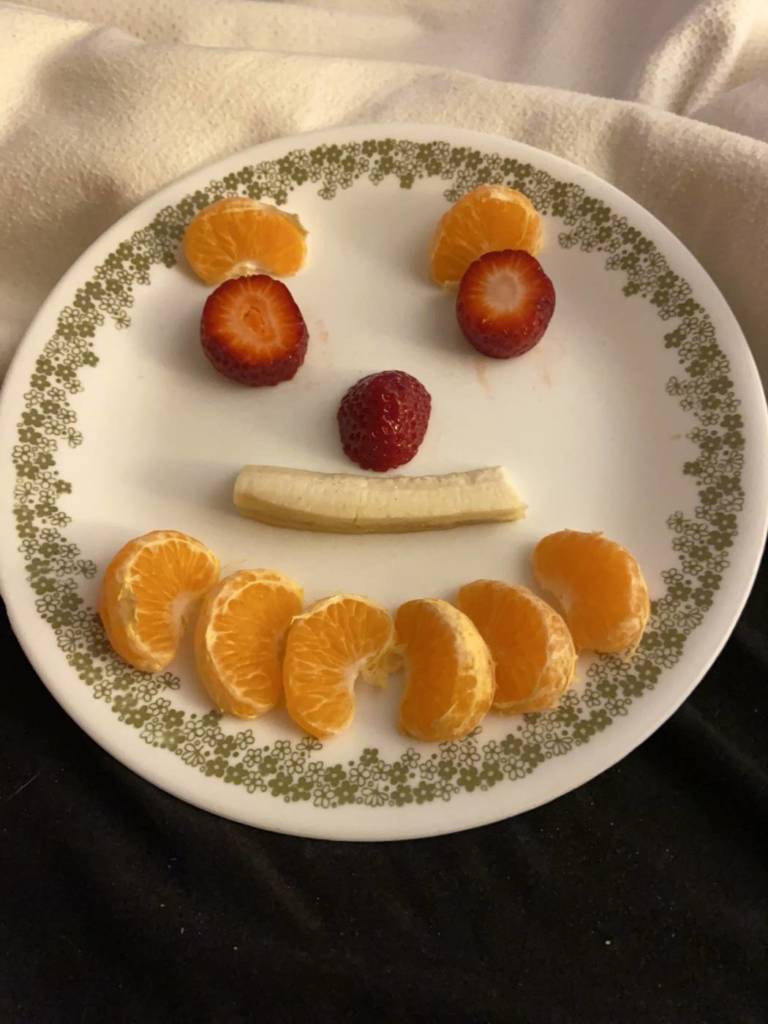
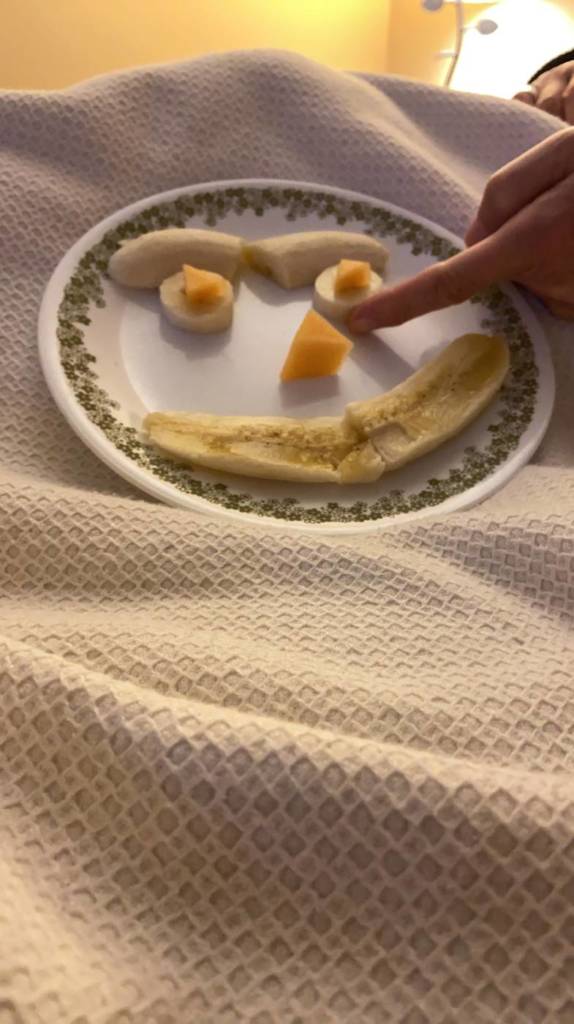
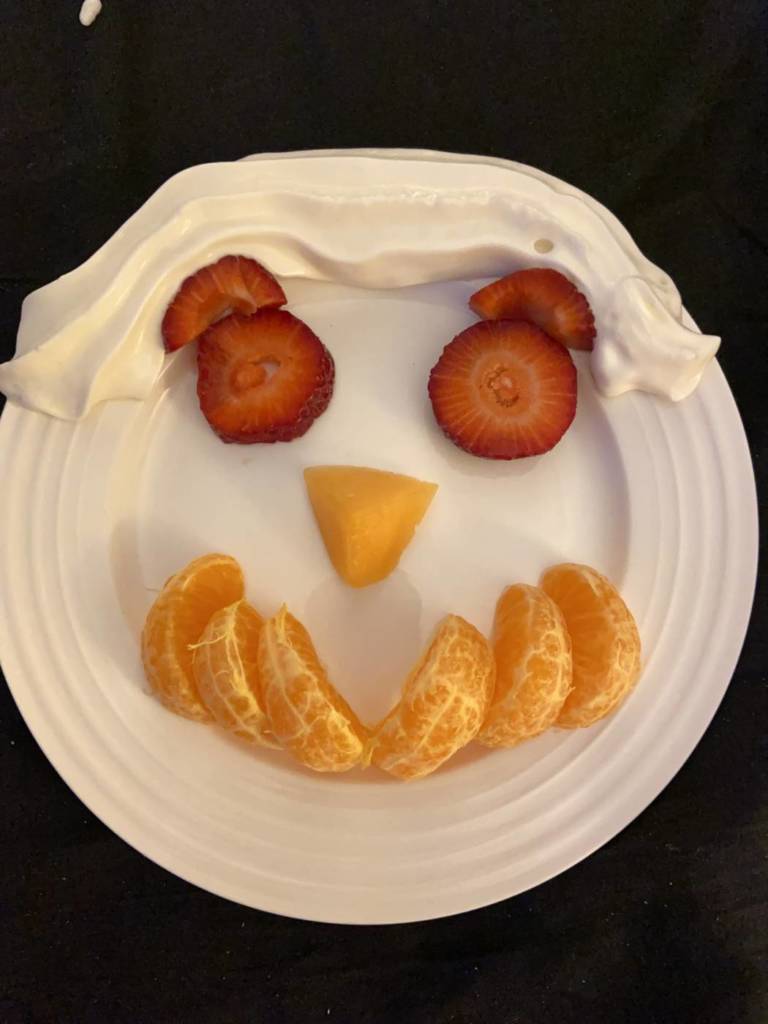
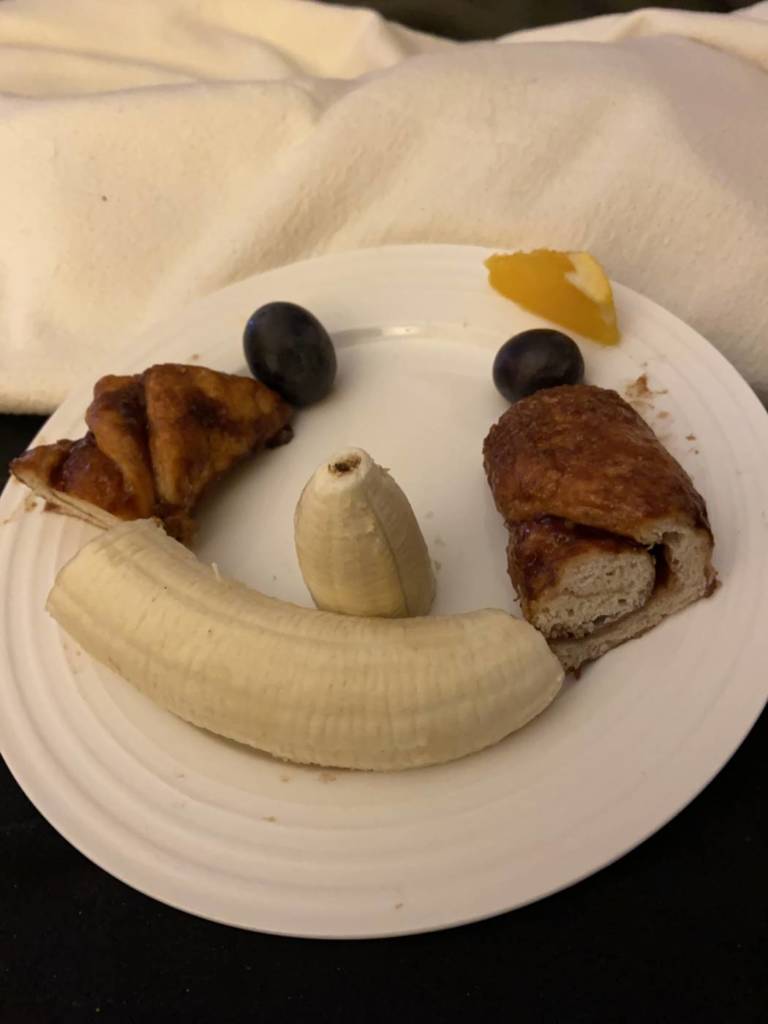
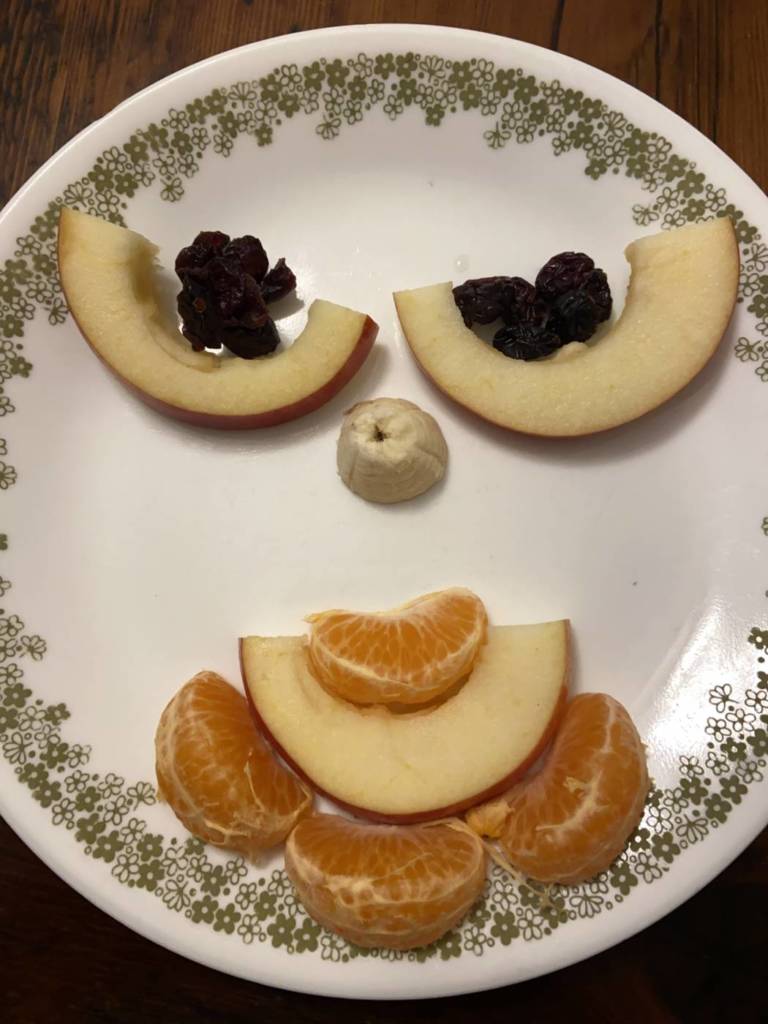
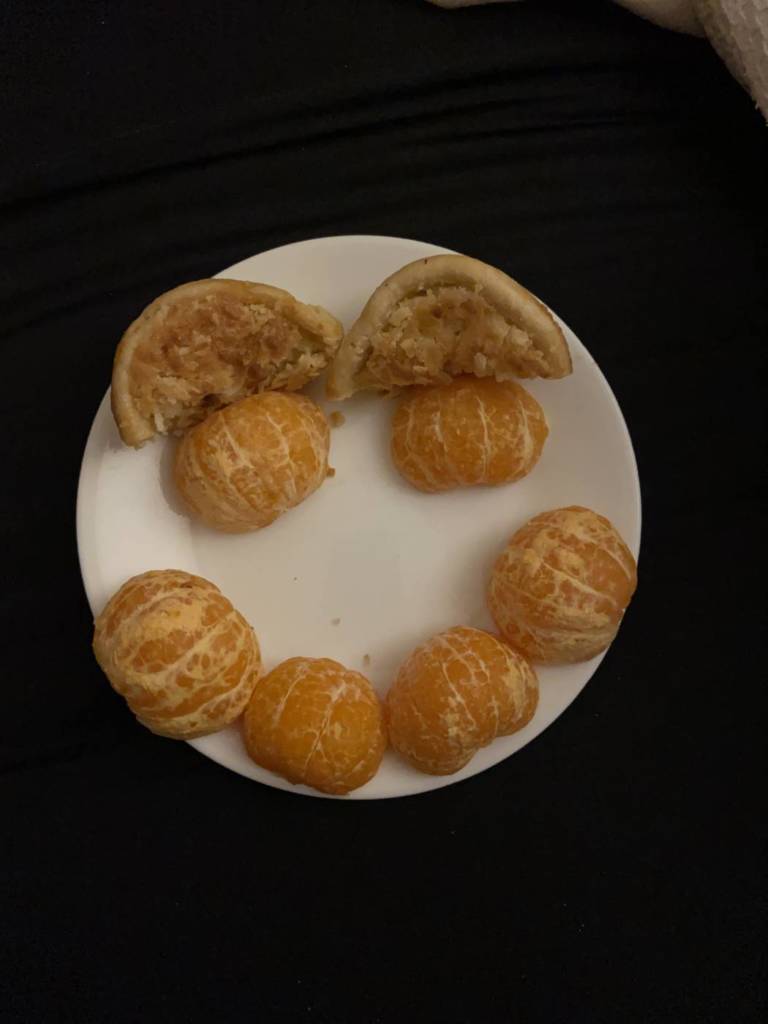



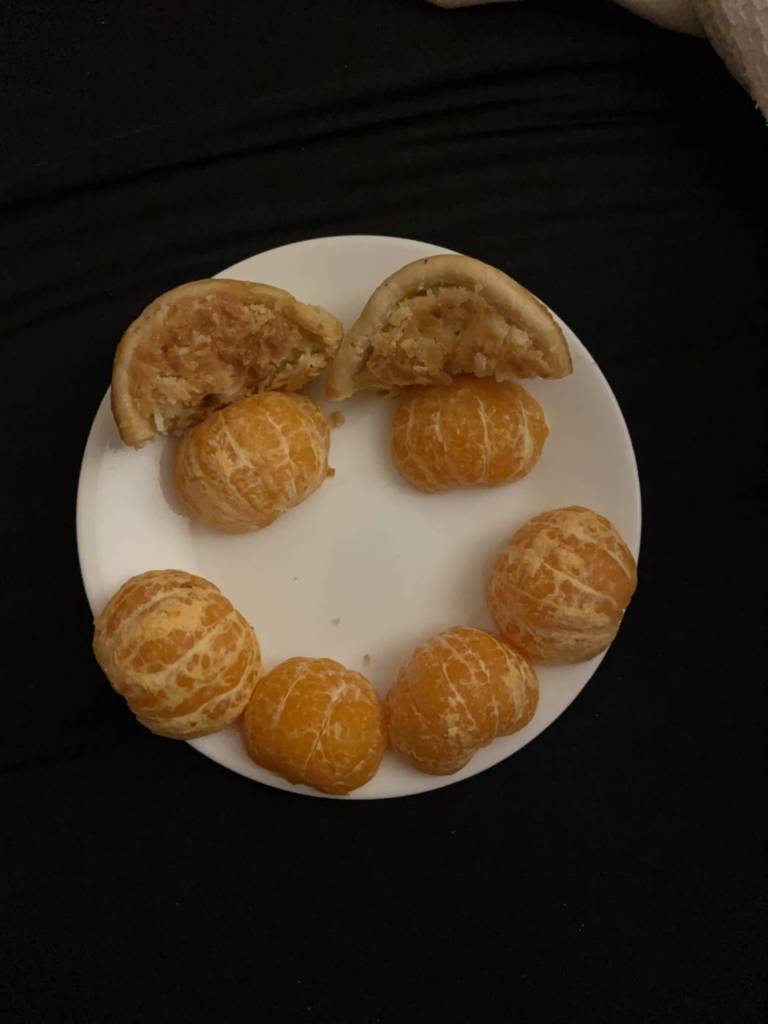
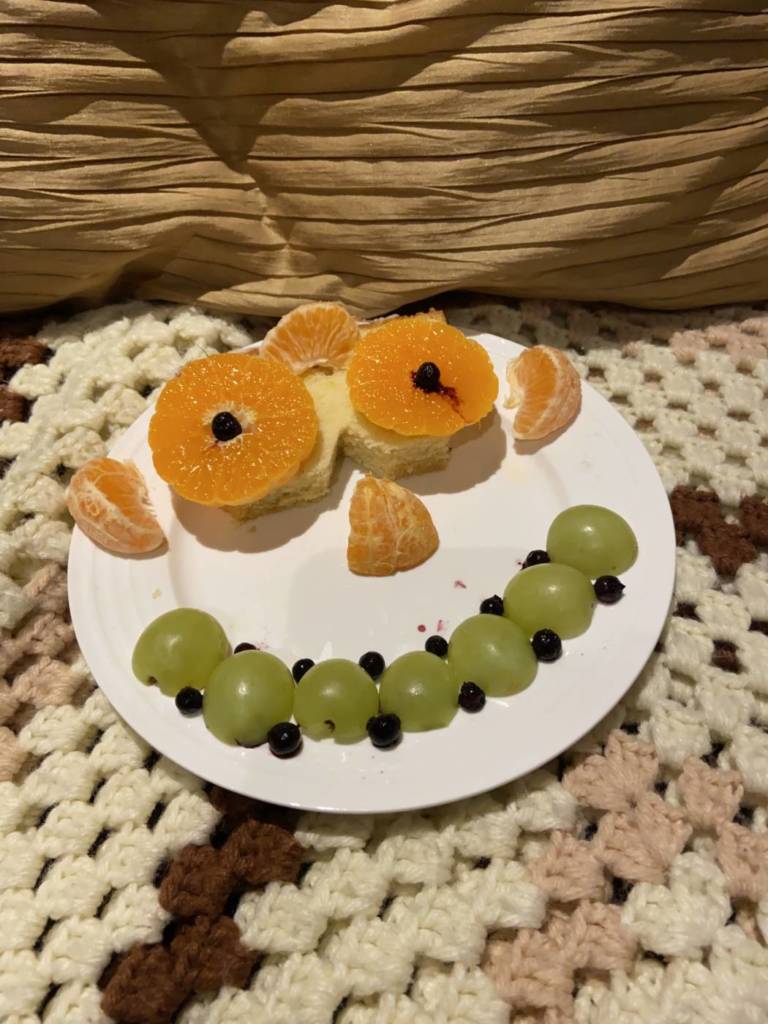

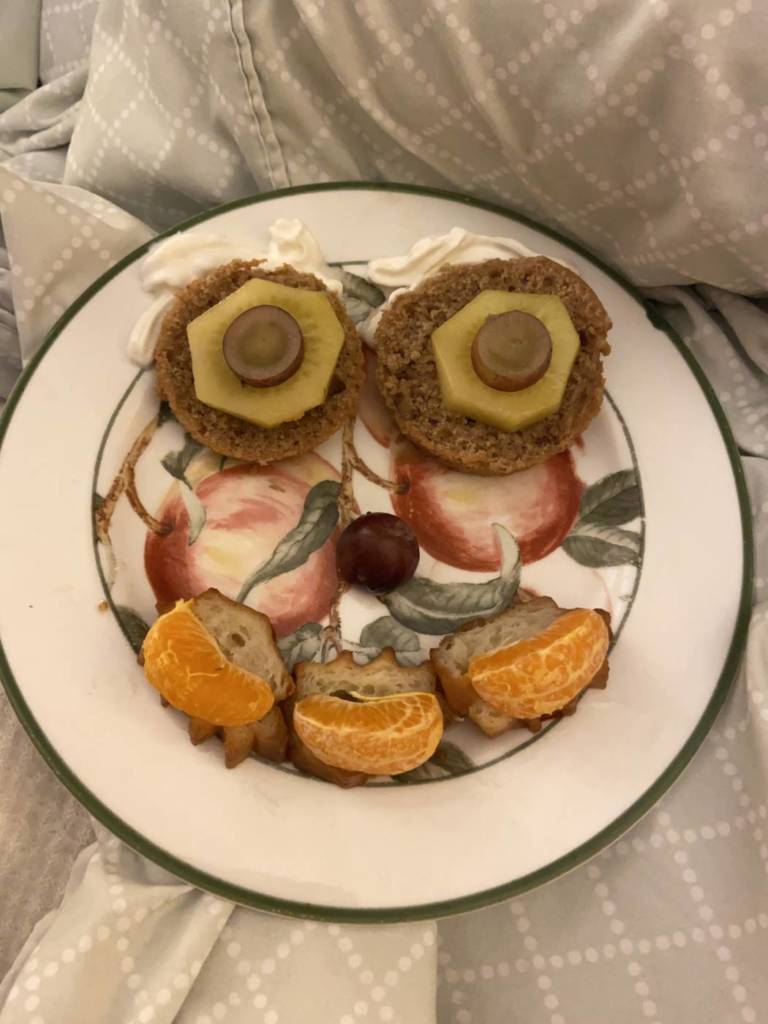
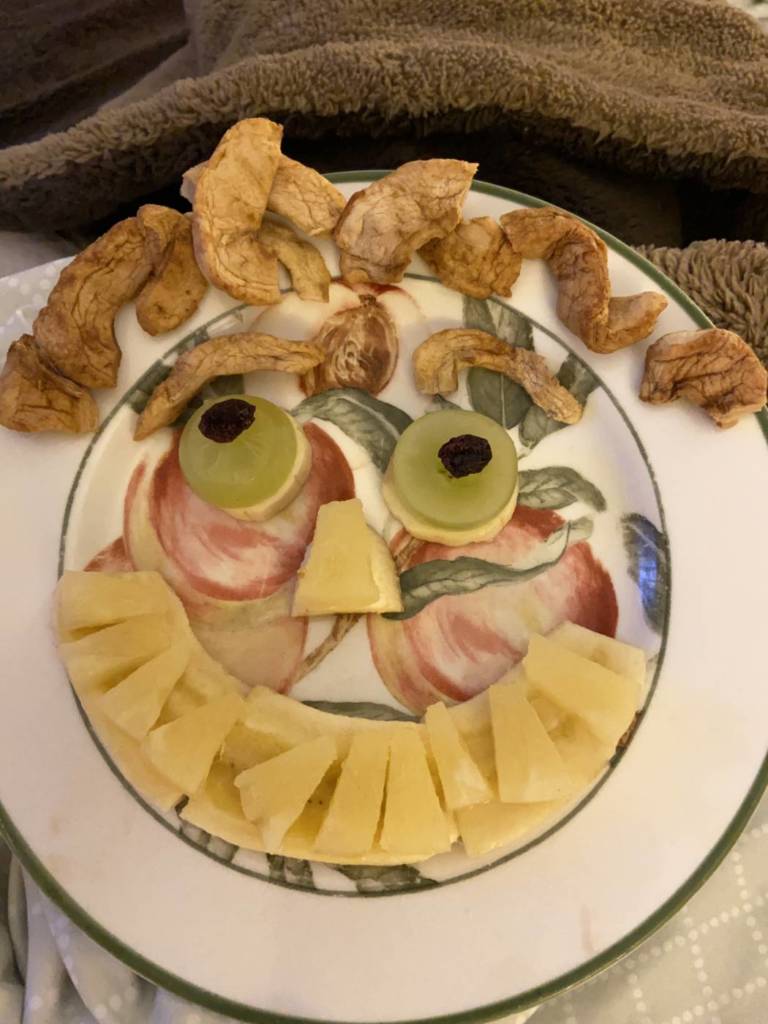
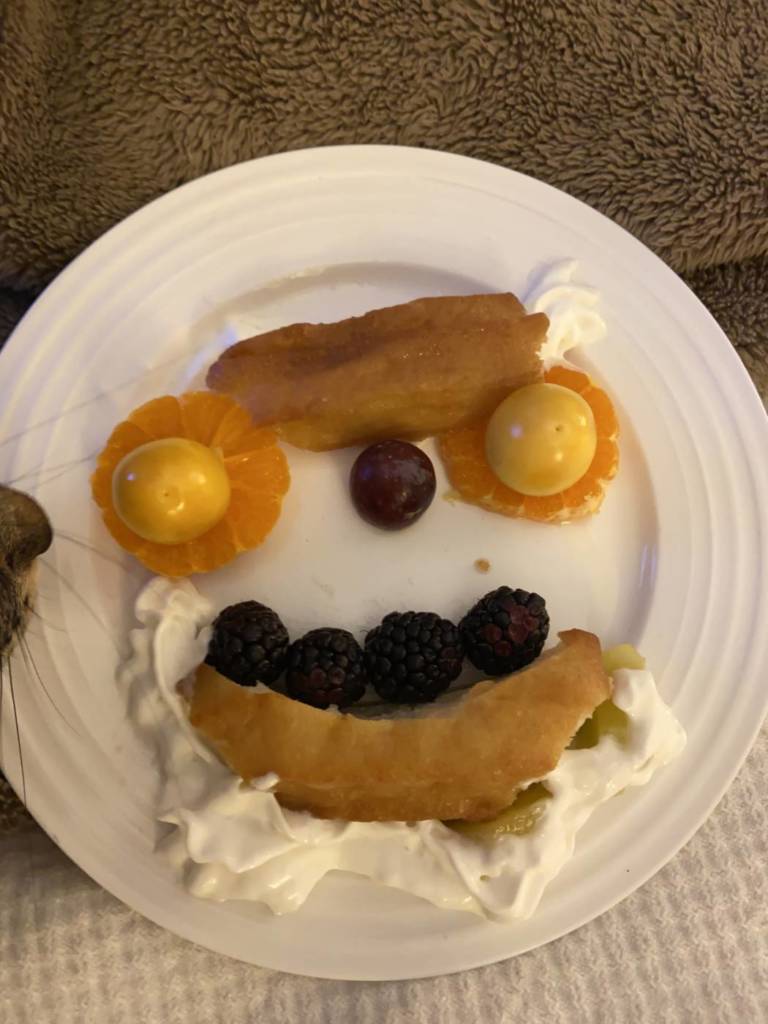
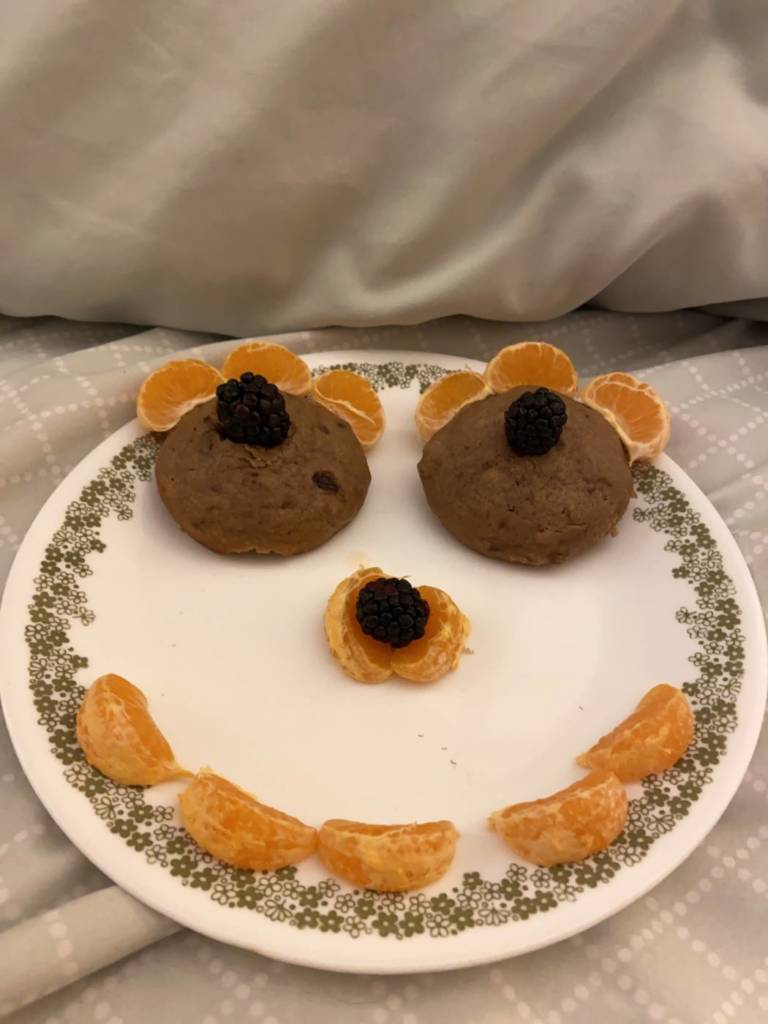

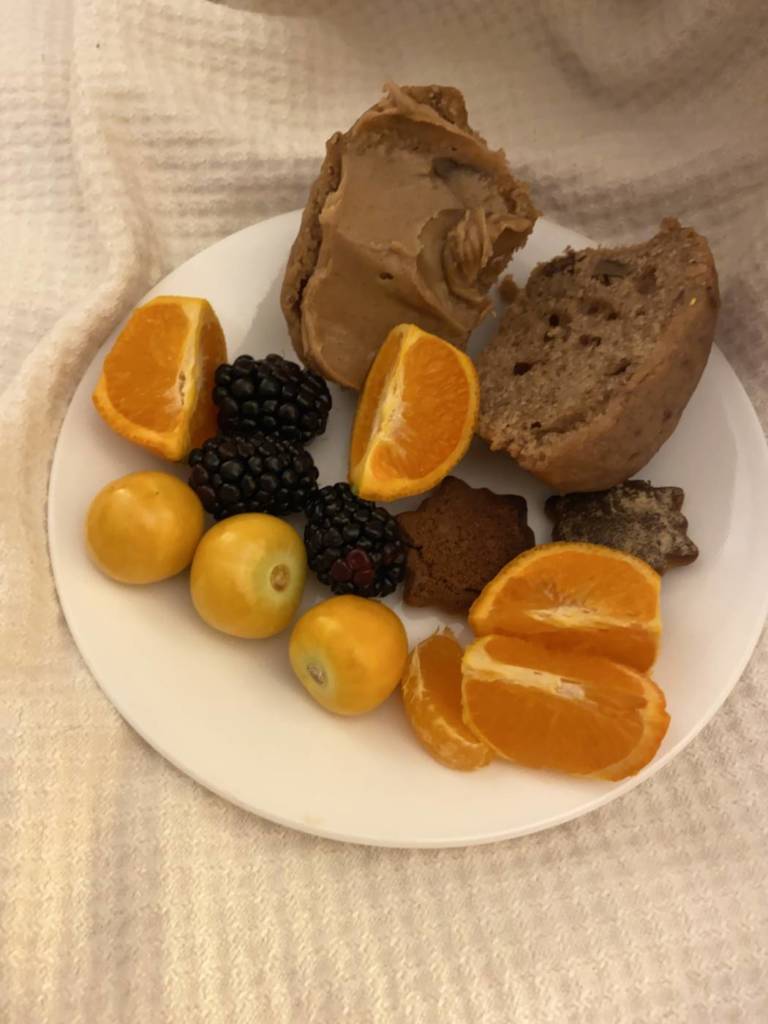
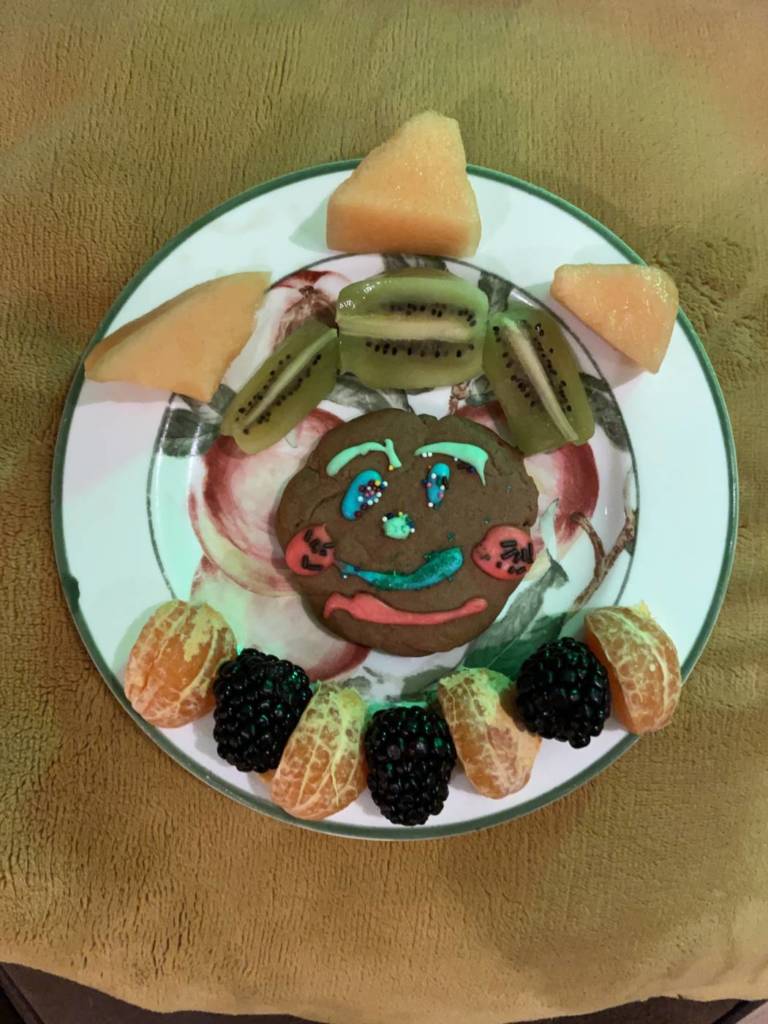
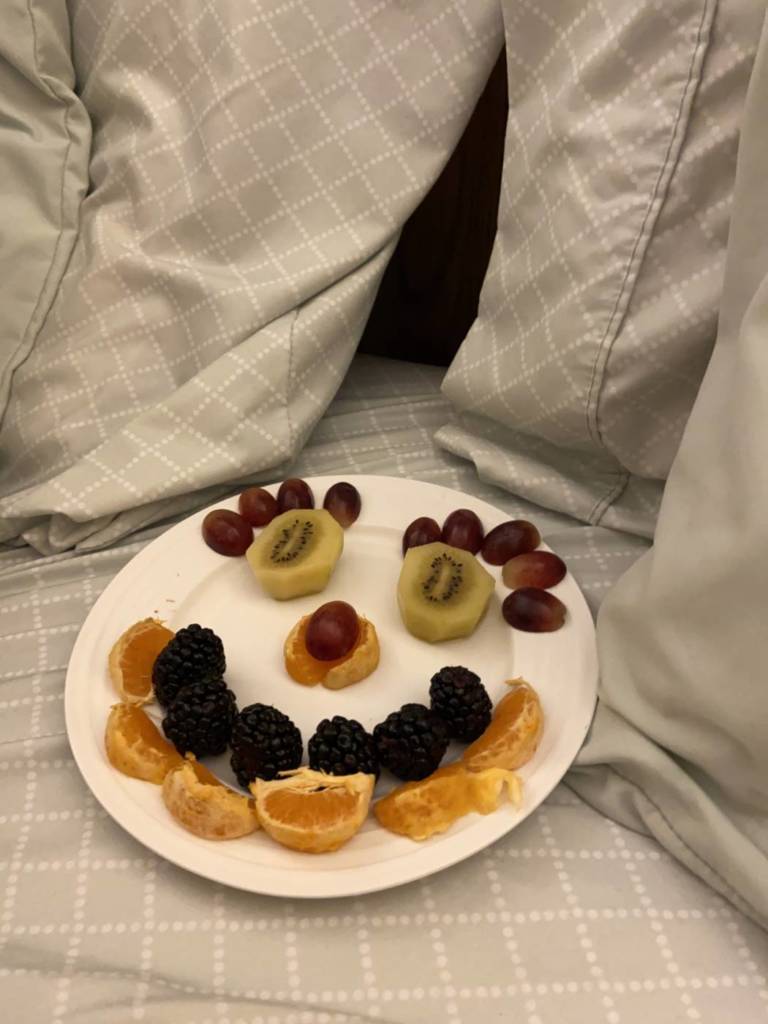
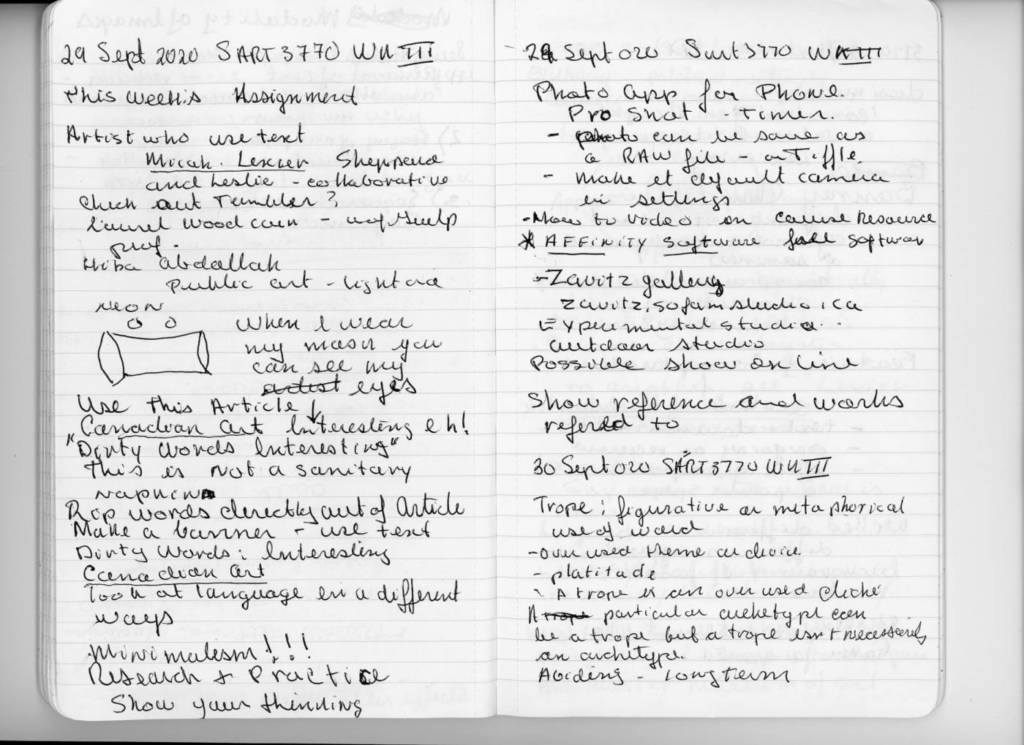
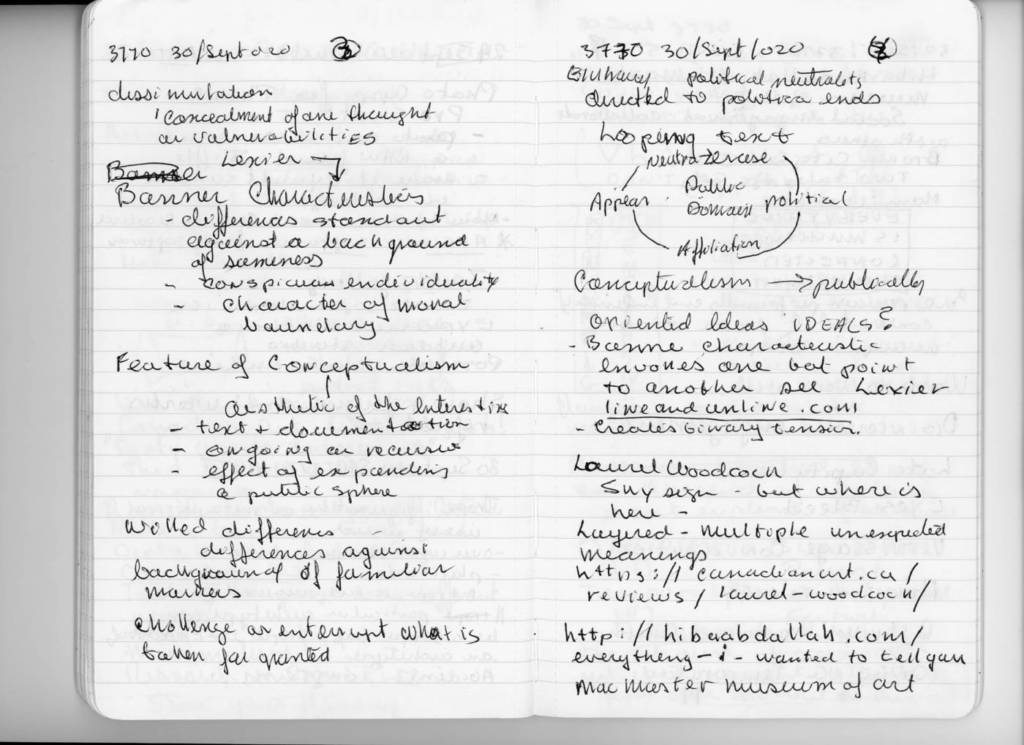
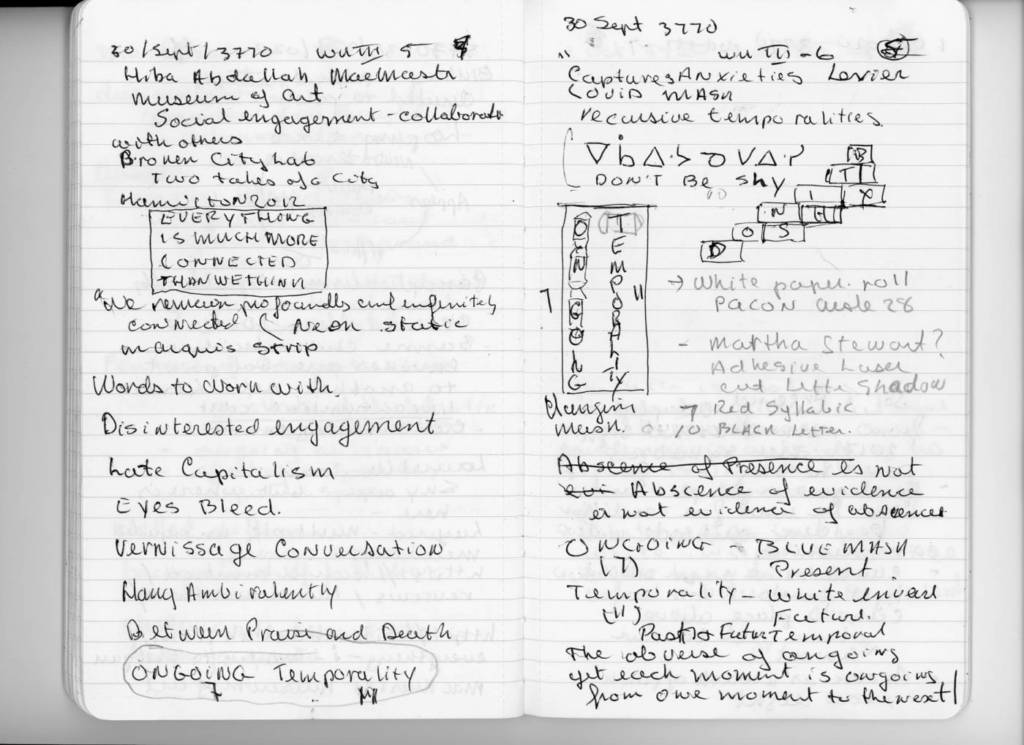
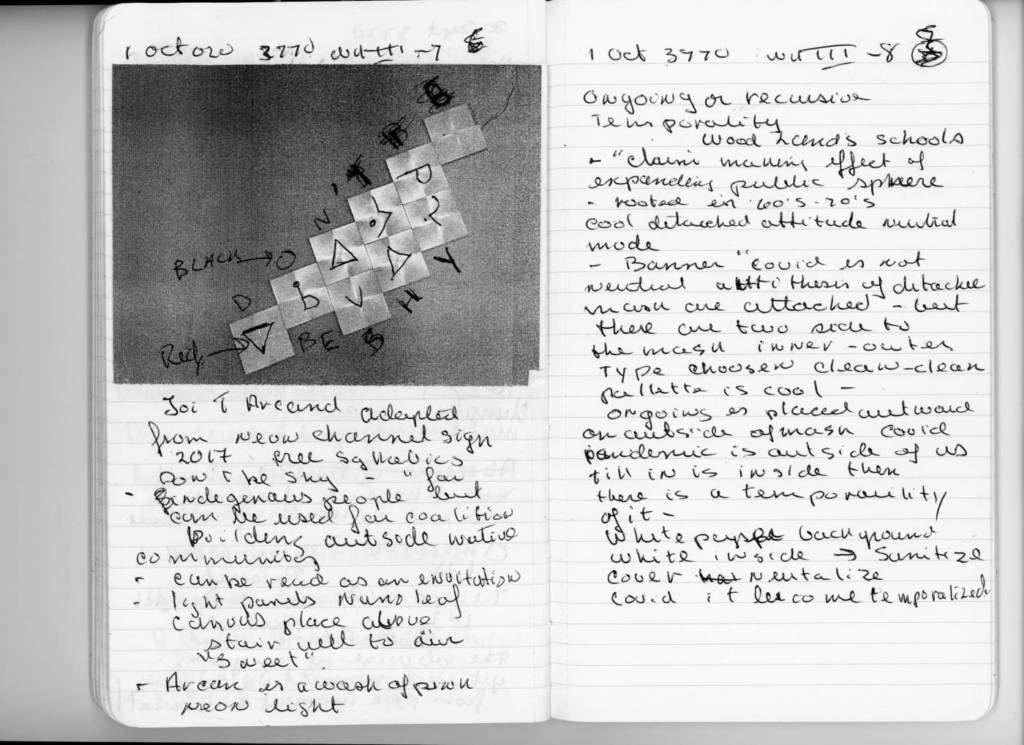
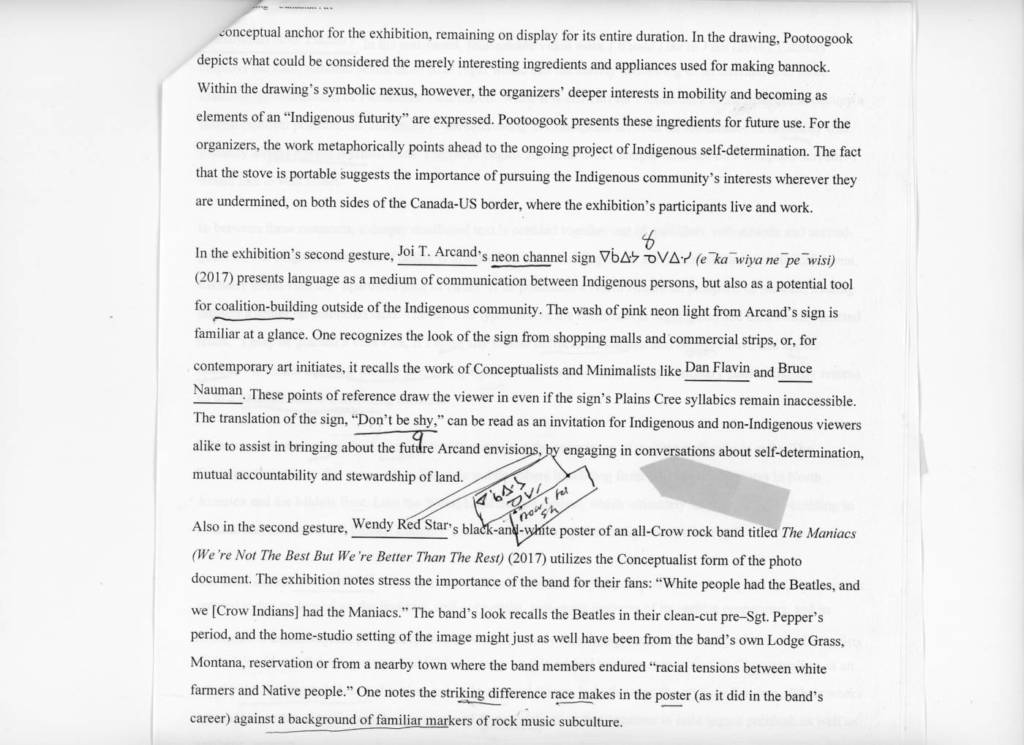


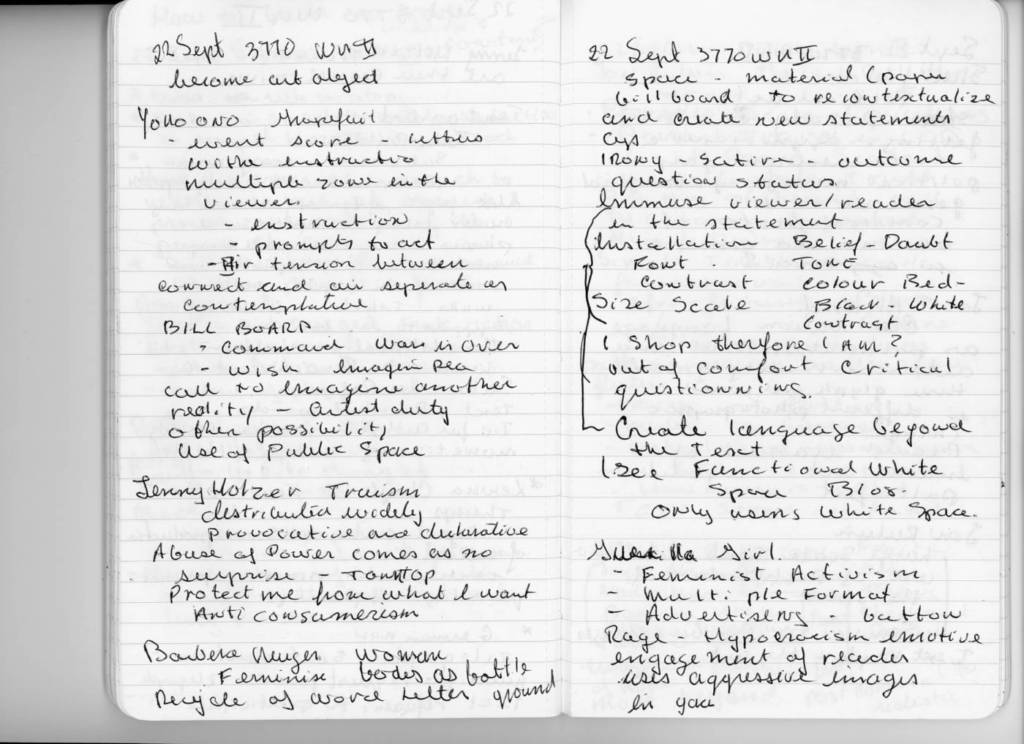
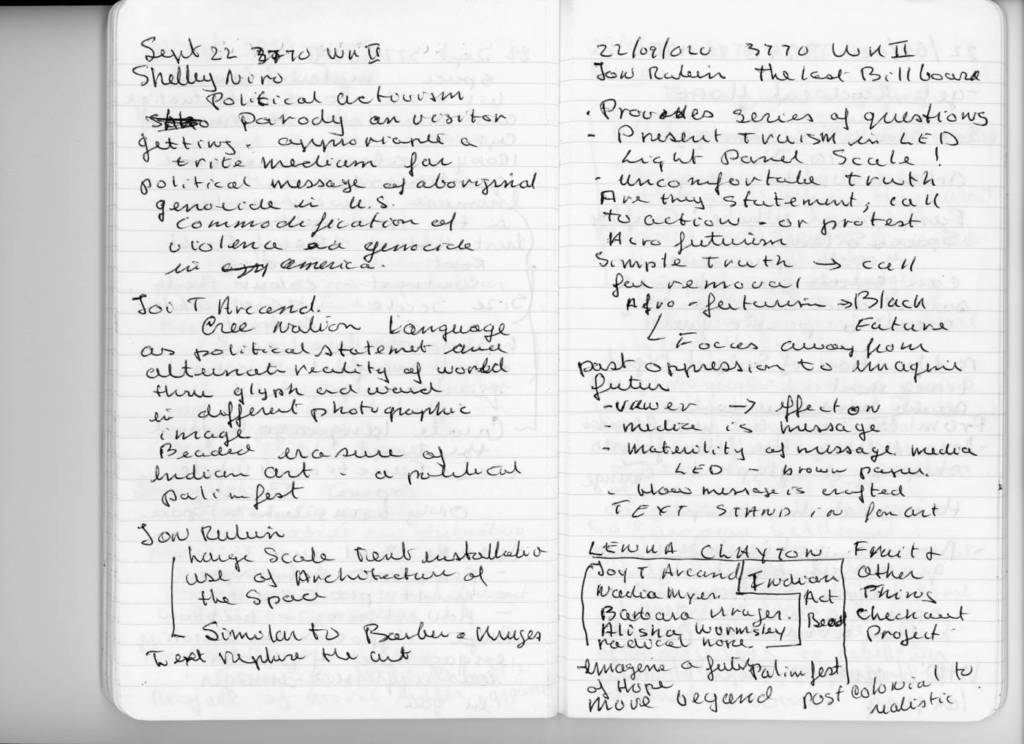
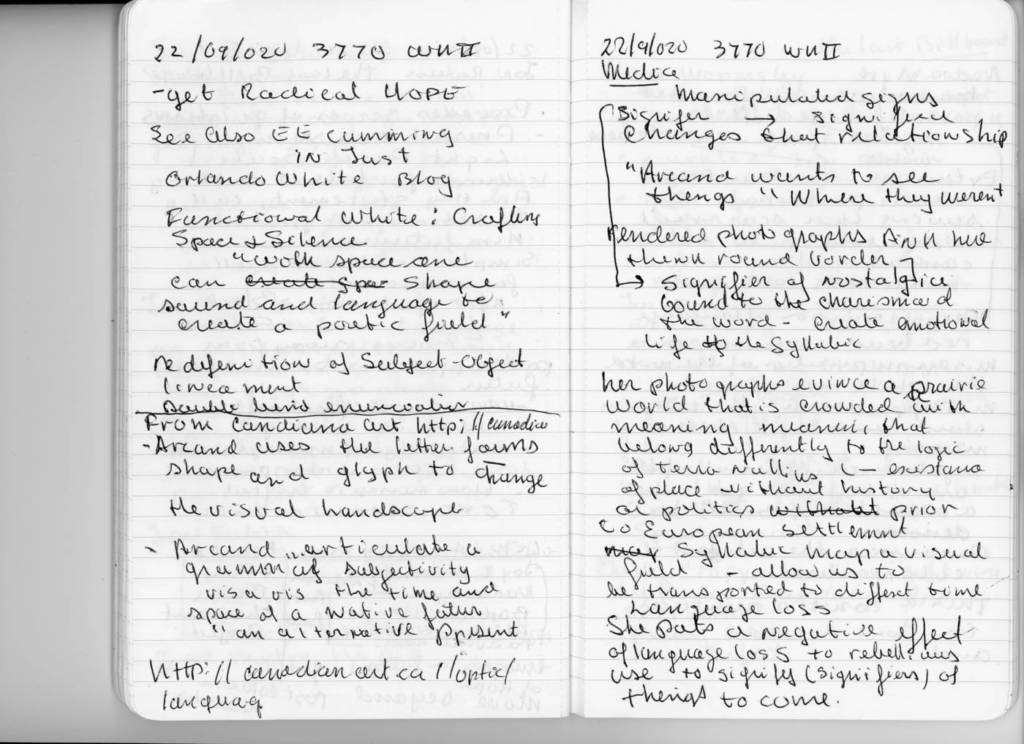

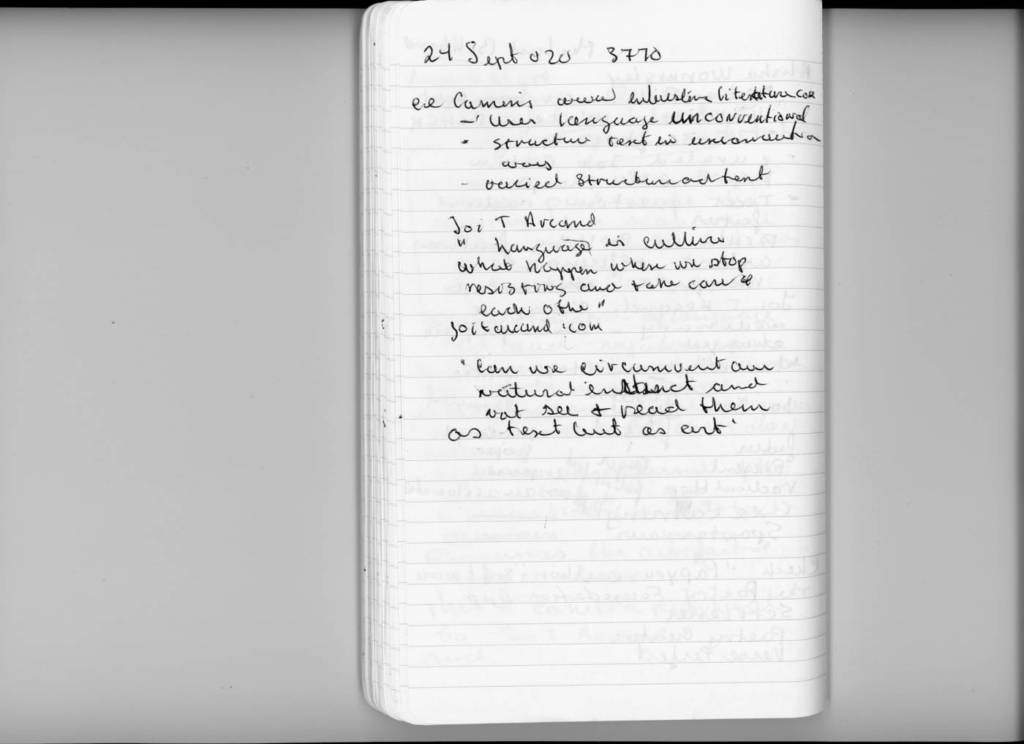
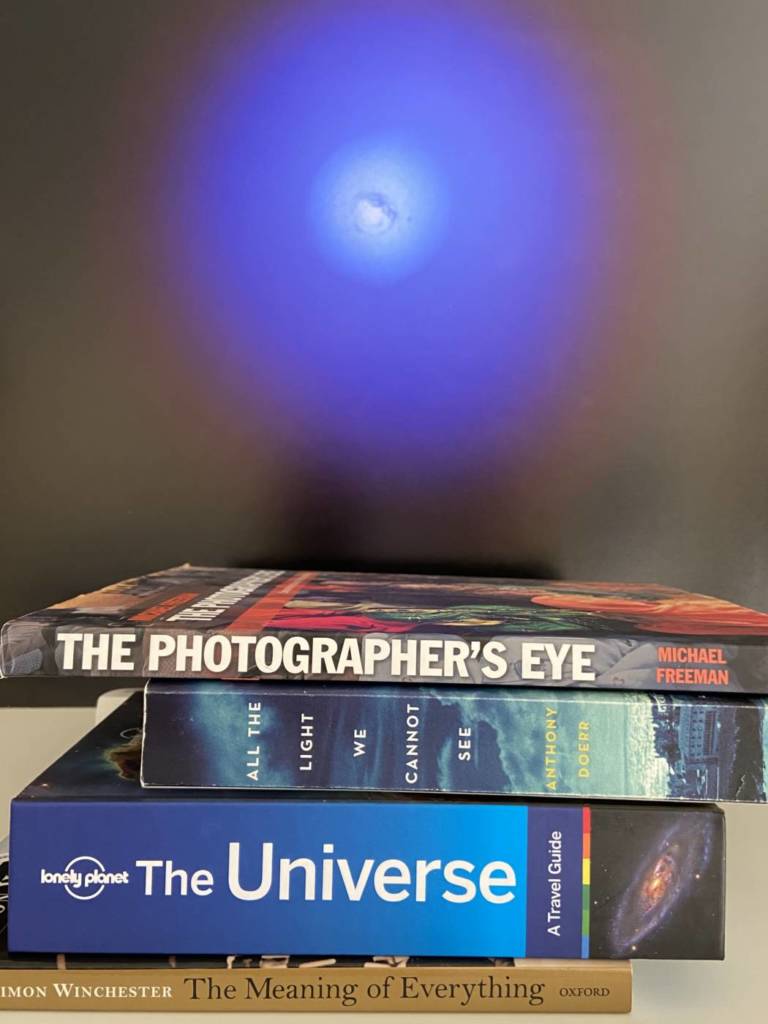
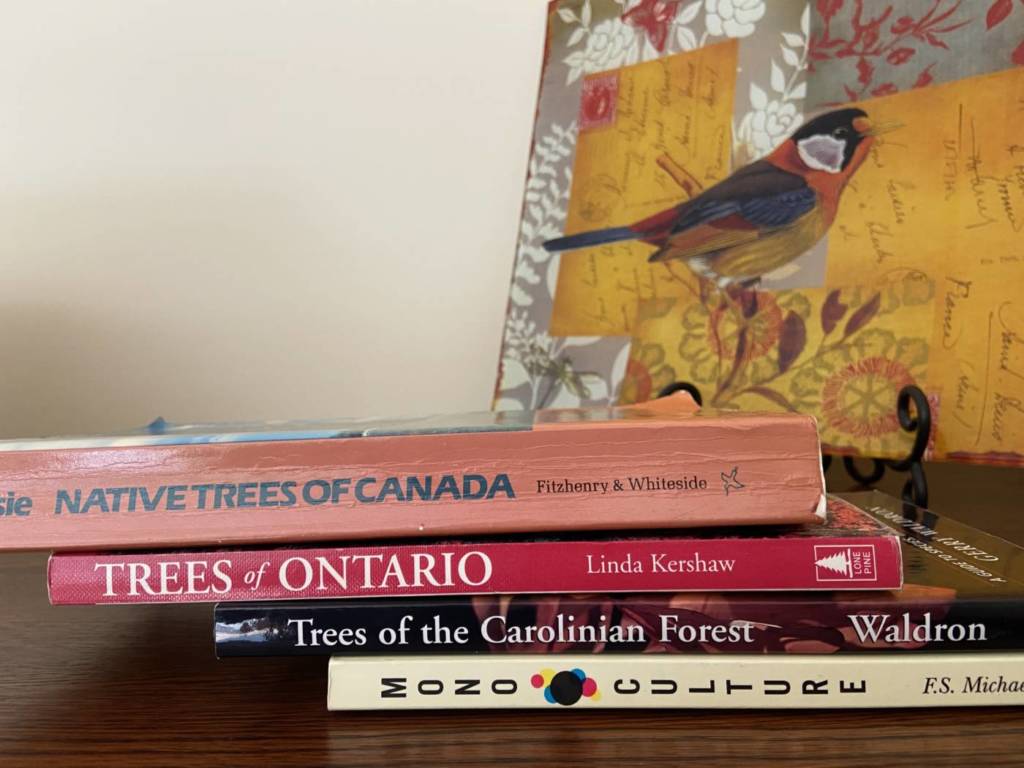

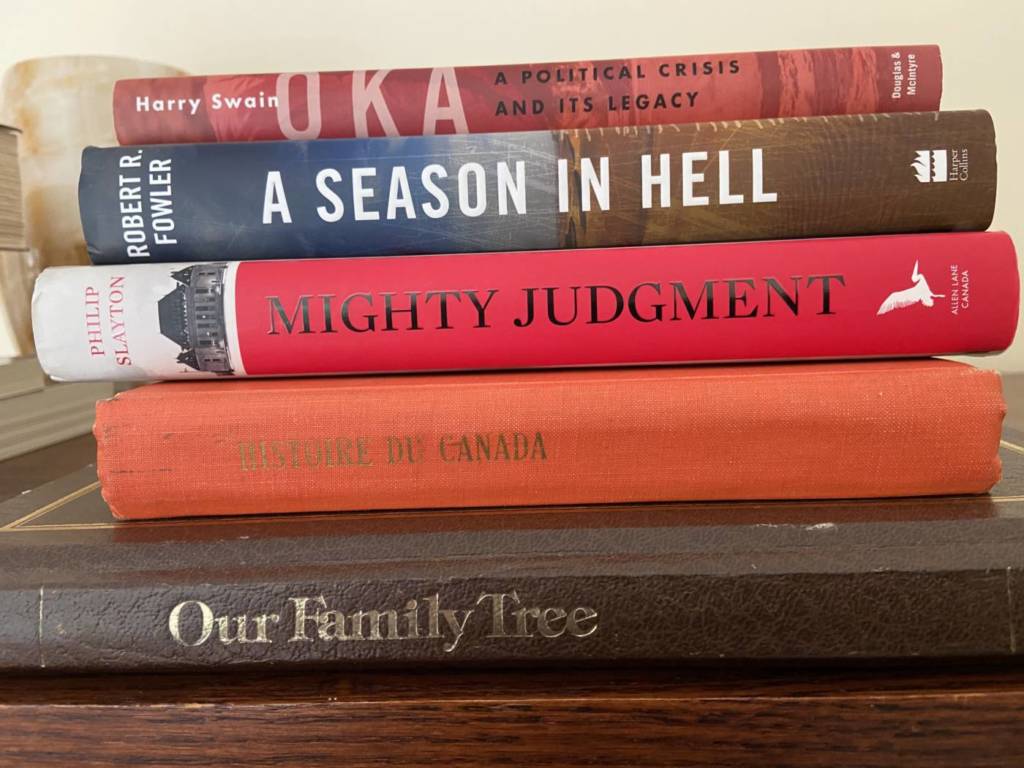
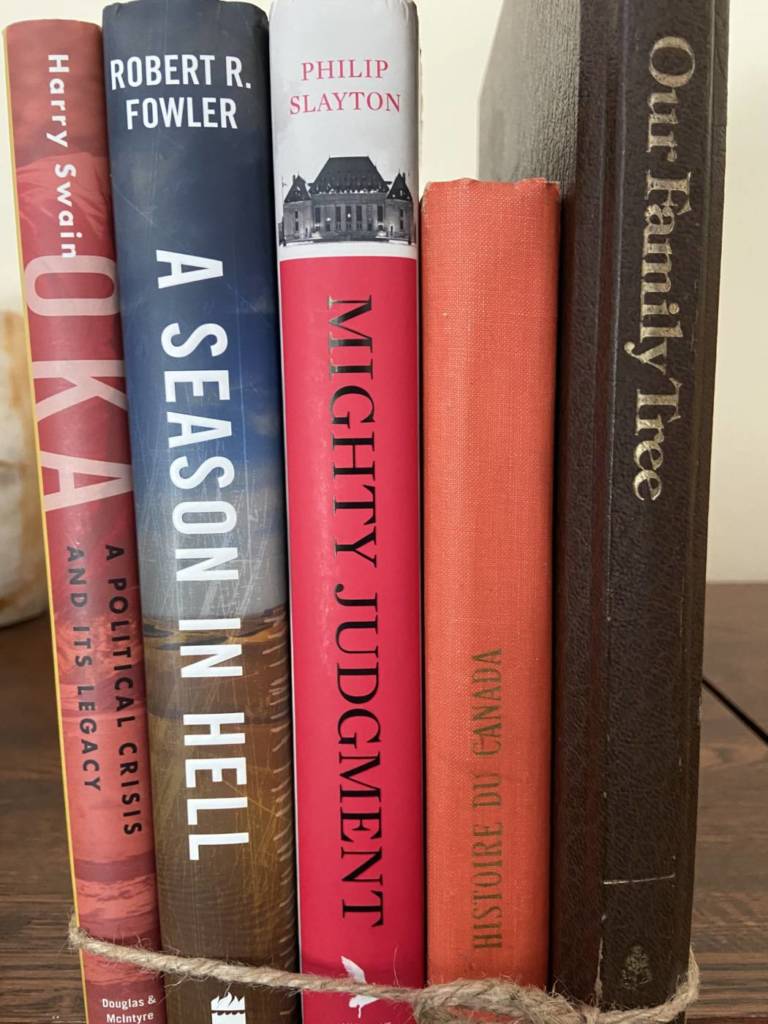
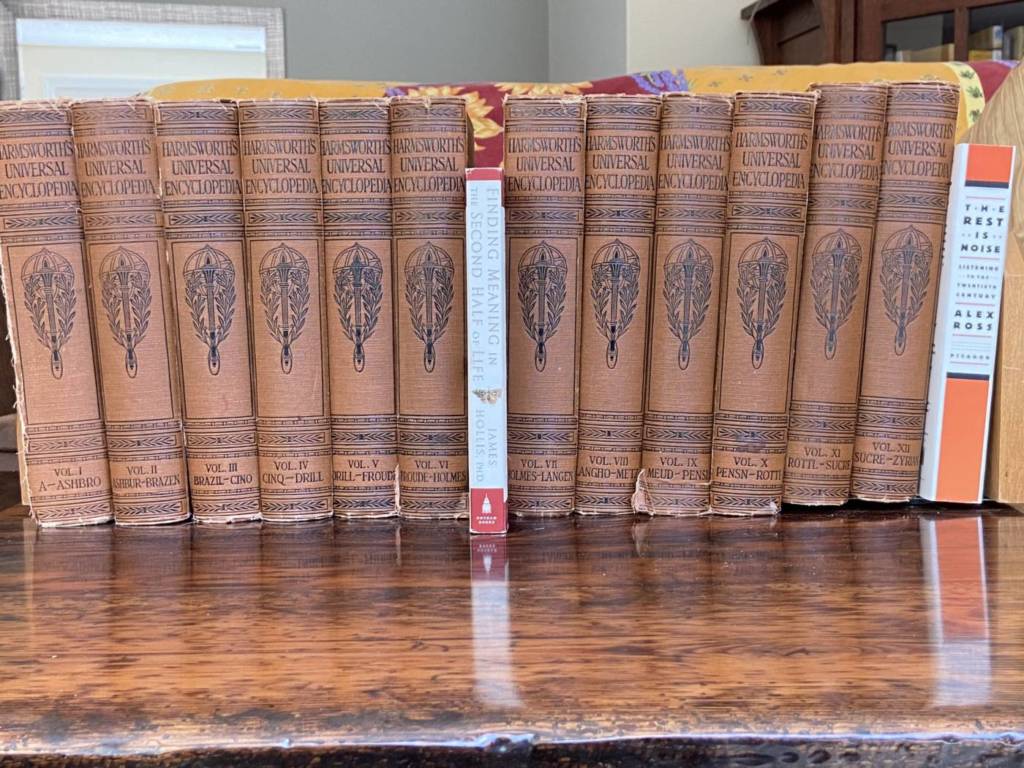
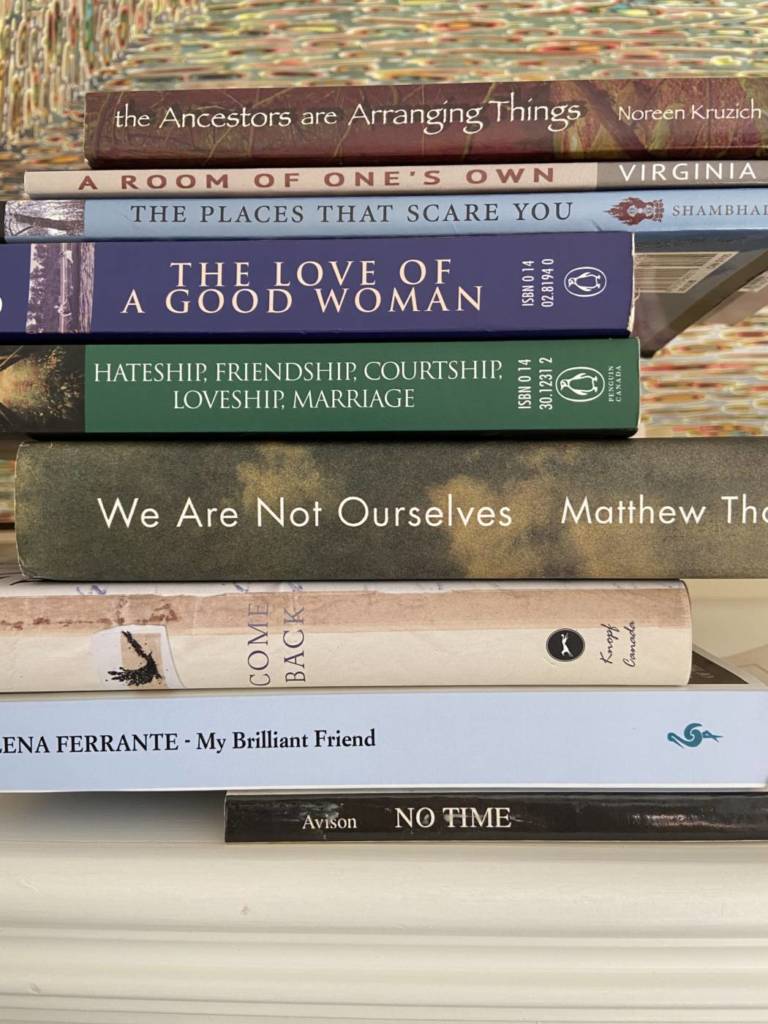
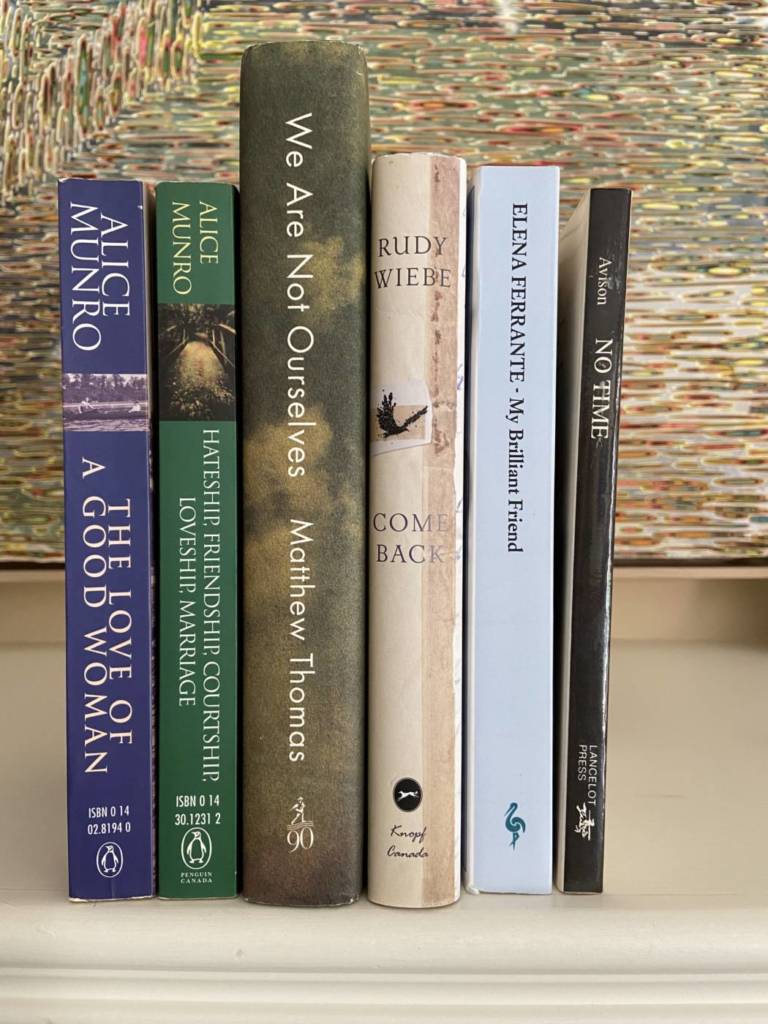
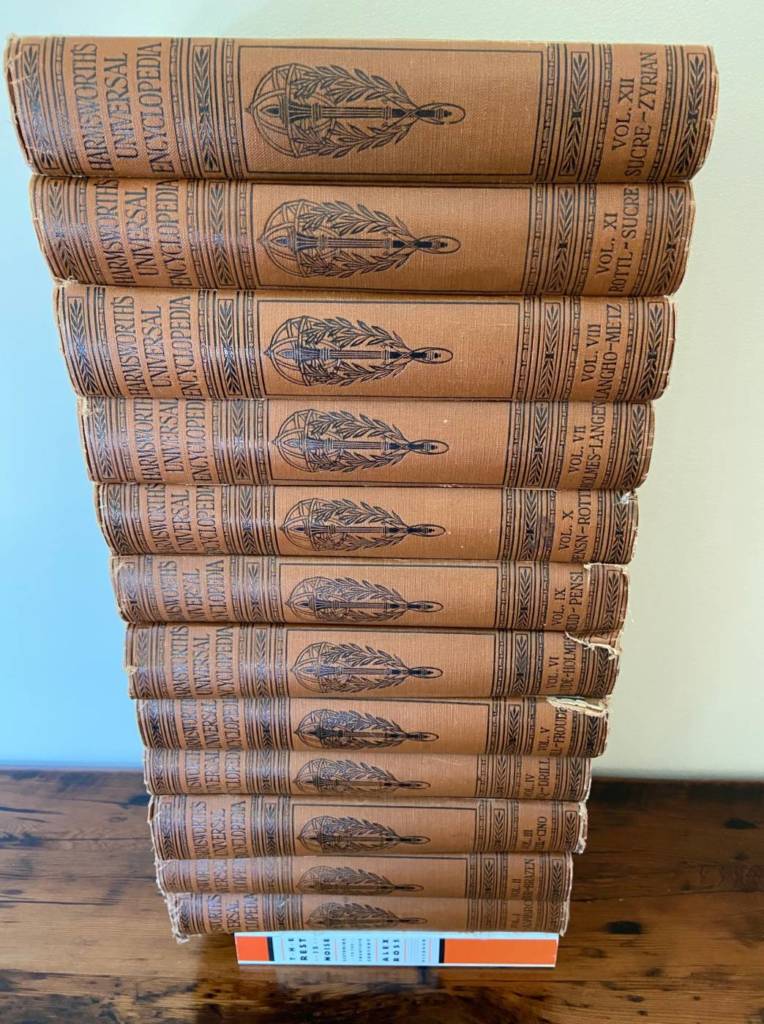
Greg
Week 1:
Katchadourian notes complete and tremendous evidence of curiosity and full engagement with material
Strong level of understanding of critical ideas at play, and I want to acknowledge just how much extra work, thinking, playing with materials and exploration you do around your projects.
3 Book stack images complete and more – I like the Encyclopedia and The Rest is Noise image most – easier to see and read – compared to the way the eye moves around too much text oriented in awkward ways in the other images. Also best not to decorate the back ground of things – it can be distracting vs. using real space, or a neutral space that disappears.
Week 2:
Notes on two text works more than complete,
plenty of evidence of curiosity and full engagement with material, and extra research, and level of understanding of critical ideas at play
Week 3:
Text banner exercise and description – so much effort – as discussed sometimes you may need to “do less” or be more concise and not over determine your gestures. But great effort to explore and work on this! Works show evidence of thinking through the historical moment for the work, understanding of conceptual ideas at play,
good evidence of technical investment and effort,
very good evidence of experimentation and adventurousness – by making things off-site and in several new ways.
Week 4:
Two Social Distancing portrait videos and more – some work more than others – I like the woman on the slide – but if she were centred it would look more intentional. Funny sound! But sound is all forgiven for this work (hard to get a kid to stay still!). Shows you looked closely at the Hannah and tried many iterations of this exercise.
Excellent attendance and engagement in class, thanks for participation so wholeheartedly in the in-class exercises too – I value your contributions and enjoy having you in the class!
Note to students:
If you would like to talk with me about your work in progress, readings, exercises, one-on-one comments on your work, and grades – send me an email in the morning to book a 15 minute appointment during my office hours: Thursdays 1:30-3
And you can show up to a zoom meeting with Nathan anytime during these hours to ask your questions, and get tech support for using software and finishing your projects:
Mondays and Thursdays 1-4pm